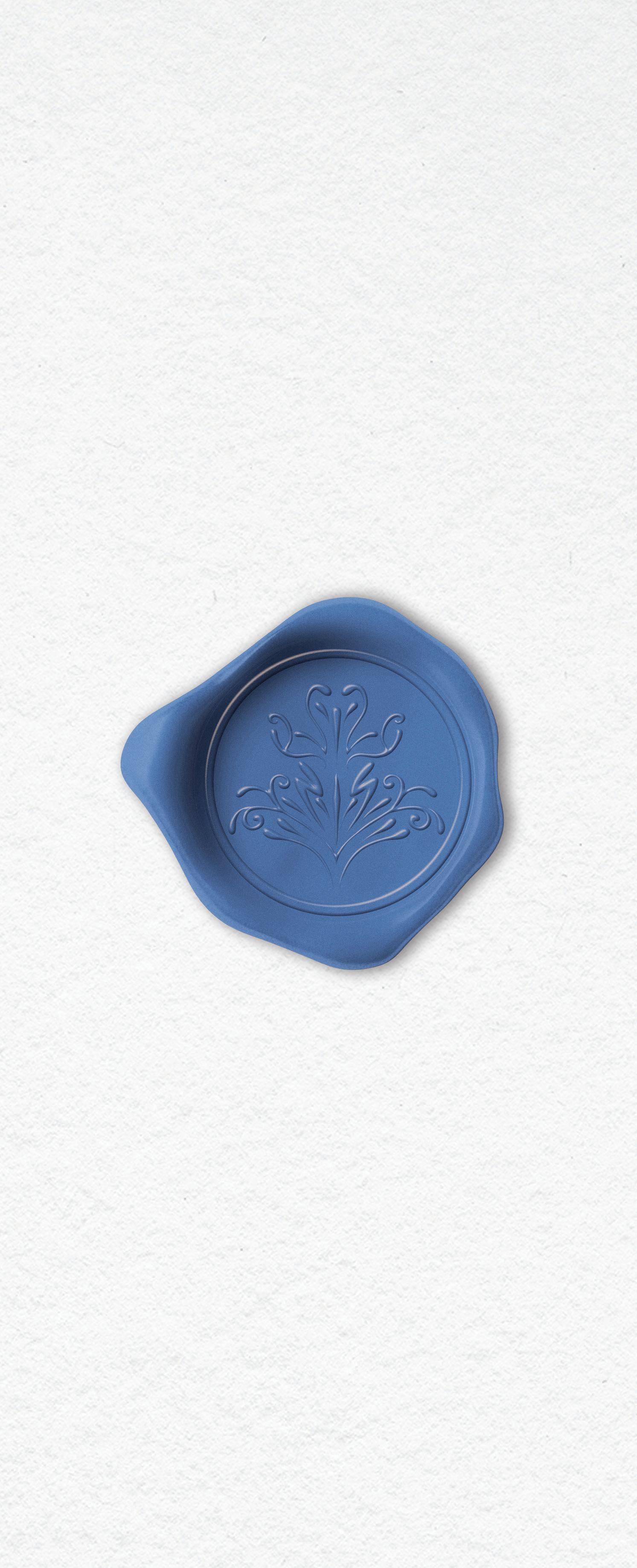












Issue 14 unravels the essence of timelessness, revealing what truly inspires endurance and what makes something endure. Fashion has long upheld a narrow vision of what is considered ‘timeless,’ but Issue 14 challenges this perspective, boldly declaring that all styles are equally eternal. All aesthetics and styles stand on equal ground, proving that timelessness transcends a single look.
By reimagining the relationship between past, present and future, Issue 14 expands Strike’s evolving narrative while staying rooted in the legacy of creativity that came before it. We reject the idea that timelessness is static but rather an ever-shifting force — fluid, boundless and deeply personal.
This issue is not just a reflection of fashion’s past but a declaration of its limitless future. Through striking visuals and bold storytelling, we invite readers to reconsider what it means for something to endure. In the world of creativity, nothing fades; it only transforms.

Sophia Johns Editor-in-Chief
Strike Magazine Gainesville embraces the belief that we are all inherently striking. Together, we strive to create immersive experiences that transcend traditional boundaries, igniting dynamic connections across fashion, art and culture.
Founded in March 2018, Strike Magazine Gainesville was the first expansion from its Tallahassee roots, rapidly growing to include 14 more branches nationwide. Since then, our team has expanded to over 180 members per issue. Strike serves as both a creative outlet and a space for professional development, fostering passion and ambition among our staff. We take pride in shaping Gainesville’s creative landscape as the first student-led publication of our kind and now as the nation’s largest student-run fashion and culture magazine.
As the editors, we are honored to lead a team that thrives on creativity, inclusivity and innovation. Each member plays a vital role in shaping the distinct identity of our chapter. We are committed to empowering our readers to think beyond traditional boundaries and embrace new perspectives as we explore new creative frontiers, upholding Strike Magazine Gainesville’s tradition of excellence.
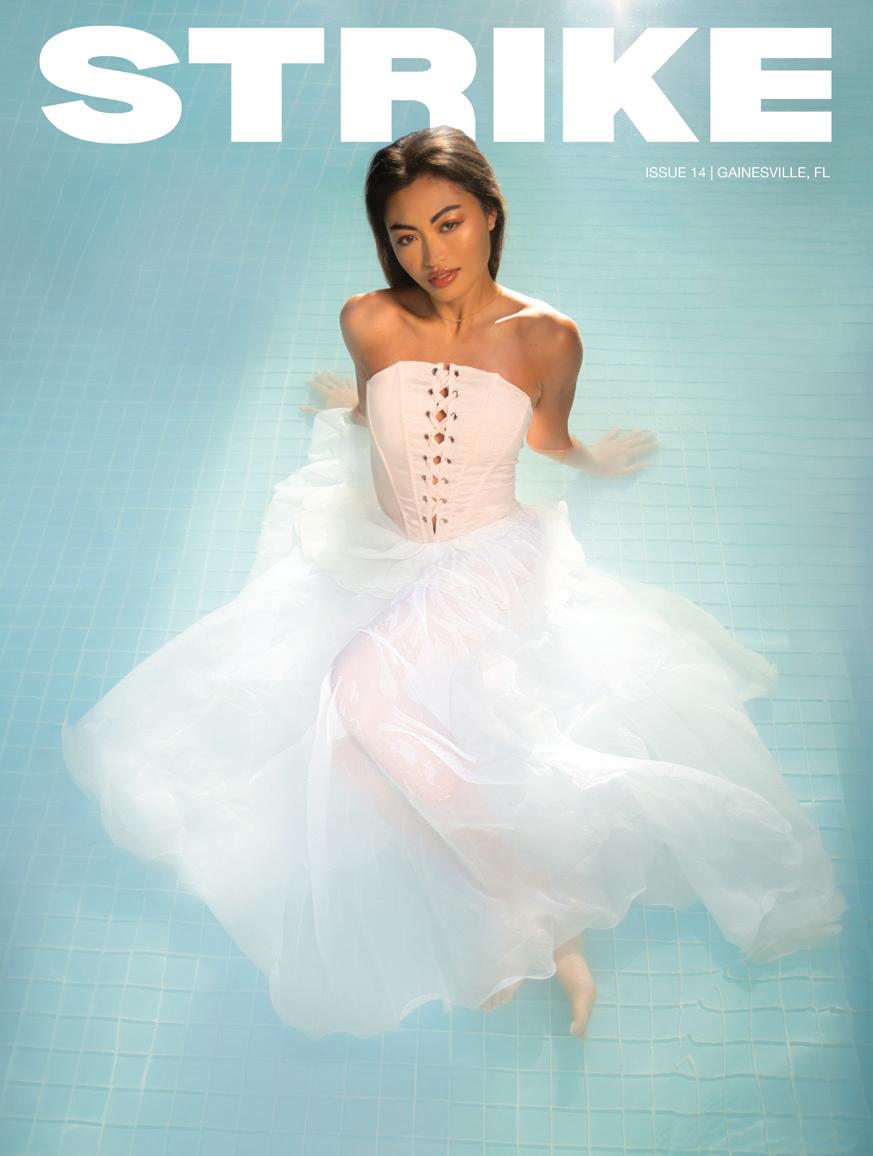
Sophia Johns
ASSISTANT EXTERNAL AFFAIRS
DIRECTOR
Caroline Rives
DIGITAL CONTENT DIRECTORS
Brynn Koepke
Brooklynn Quick
DIGITAL CONTENT ASSISTANTS
London Harper
Sanjana Imandi
Farrah Levesque
FINANCE DIRECTORS
Jewel Russell
Caroline Udell
FINANCE ASSISTANTS
Drew Cohen
Amber Dangelico
Myla Wollman
MARKETING DIRECTORS
Chloe Leib
Christina Mackey
Zachary Venezia
MARKETING ASSISTANTS
Ahmya Bullard
Camryn Costolo
Lauren Dupoux
Jessica Ensel
Reese Harper
Olivia Huey
Layla Lee
Susy Mendez
Mia Oklin
Kalina Pandelova
Oliver Rodriguez
Hannah Sanchez
Brooke Seldes
Parthvi Shah
Brooke Truffelman
MERCHANDISE DIRECTORS
Sharon Bridgemohan
Joanna Wang
MERCHANDISE ASSISTANTS
Tara Patel
Zeke Serrano
Katelyn Spohn
Isabella Truong
PUBLIC RELATIONS DIRECTORS
Gaby Ocasio
Julia Strasius
Jessica Velez
PUBLIC RELATIONS ASSISTANTS
Brenna Alderman
Elizabeth Froimzon
Anna Gilchrist
Ella Goldfarb
Marin Houser
River Koile
Hayden McPharlin
Jasmyn Reid
Peyton Richards
Abbey Schenker
Finley Schuurmans
Carly Wilson
SALES DIRECTORS
Emma Larson
James Robertson
SALES ASSISTANTS
Ellie Alvis
Evelina Khaybullina
Zoe Shlomi
Abby Whitaker
DIRECTOR
Heather Parrish
SOCIAL MEDIA DIRECTORS
Audrey Baker
Carly Weinblatt
SOCIAL MEDIA ASSISTANTS
Cora Acree
Mia Chacon
Morgan Colleluori
Ella Dang
Angelina Eidson
Daniella Milton
Jane Ruppel
Michelle Wager
BRAND AMBASSADOR DIRECTORS
Lexi Denowitz
Savannah Rude
ASSISTANT DIRECTOR
Emma Valdeon
BRAND AMBASSADORS
Timothy Addie
Jenna Benjamin
Heather Breslaw
McKenna Chase
Eden Collins
Aiden Copeland
Delaney Craig
Juanita Echeverry
Grace Galloway
Ella Gibson
Kevin Gonzalez
Elizabeth Greenless
Elizaveta Ivanova
Aishu Kandukuru
Madison Knapp
Neha Menezes
Riana Morales
Julia Passeroff
Khushi Patel
Elle Powers
Veronica Ramos
Noa Sasson
Gaby Scheiner
Rebecca Speas
Kenny Stephen
Colin Strom
Chris Webb
Violet Zeiders
ASSISTANT EDITOR-IN-CHIEF
Olivia Hansen
EDITORIAL DIRECTORS
Naina Chauhan
Olivia Evans
COPY EDITORS
Halima Attah
Hailey Indigo
WRITERS
Michael Angee
Sofia Bravo
Melody Gu
McCall Horton
Francesca Jaques
Autumn Johnstone
Ginger Koehler
Laila Mayfield
Rachel Mish
Ria Pai
Sofia Sepielli
Allie Sinkovich
CREATIVE DIRECTOR
Rachel Frenchman
ASSISTANT CREATIVE DIRECTOR
Jesse Pickel
BEAUTY DIRECTORS
Hailey Goldstein
Jena Poorman
MAKEUP ARTISTS
Ava Anderson
Geovanna Berguin
Paige Lorbiecki
Laasya Moparthy
HAIR STYLISTS
Jordon Miller
Christina Spindler
Lindsay Stagnitto
NAIL ARTIST
Evangeline Wriedt
CASTING DIRECTORS
Nicole Ballesteros
Alexa Craig
ASSISTANTS
Ellie Bender
Ryan Esteras Escobar
Marisa Greenberg
Roma Khanna
Kendall Lagana
Jessica Nitti
DESIGN DIRECTOR
Jackson Asbell
GRAPHIC DESIGNERS
Hayli Balgobin
Zoe Chu
Keegan Hannan
Rhythm Kumar
Reed Mann
Emma Morey
FILM DIRECTORS
Camila Celaya
Jaden Jerue
FILM ASSISTANTS
Alessia Lavayen
Matthew Maykut
Anna McFarland
Gabby Randerson
Isabella Sangrador
Macey Woodburn
PHOTOGRAPHY DIRECTORS
Grace Barney Eden Hetzroni
PHOTOGRAPHERS
Cheyenne Band
Leila Barket
Gabriella Childers
Mary Kate Farrell
Madilyn Gemme
Macy Phan
Annika Thiim
Vanessa Yanes
PRODUCTION DIRECTORS
Krista Kilburg
Cameron Relicke
Ben Robinson
PRODUCTION ASSISTANTS
Colby Beech
Chloe Crews
Avery Donaldson
Presley Lomel
Nick Rymarz
Jennifer Thaler
Kya Williams
STYLING DIRECTORS
Stephanie Goris
Tabi Higgins
STYLISTS
Camila Celaya
Isabella Clark
Georgia Harris
Keegan Hannan
Amaia Morgan
Ava Powers
Ben Robinson
Corrine Speed
Hadley Susa
Chloe Zijl
BOOKING COORDINATORS
Bridget Connor
Brooke Park


A reimagining of structure and perception — bending the norm, reframing form and blurring the line between the familiar and the surreal.





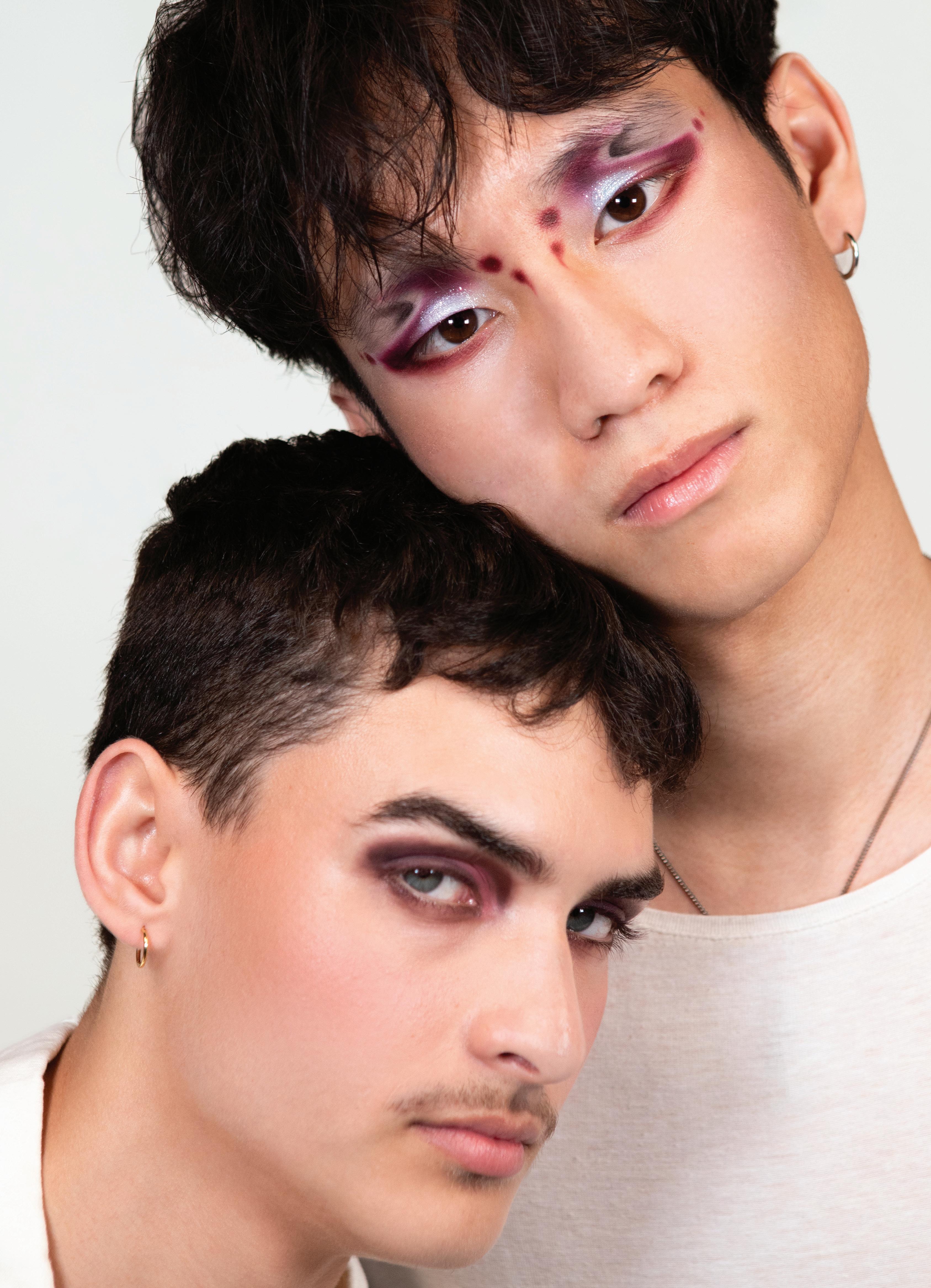
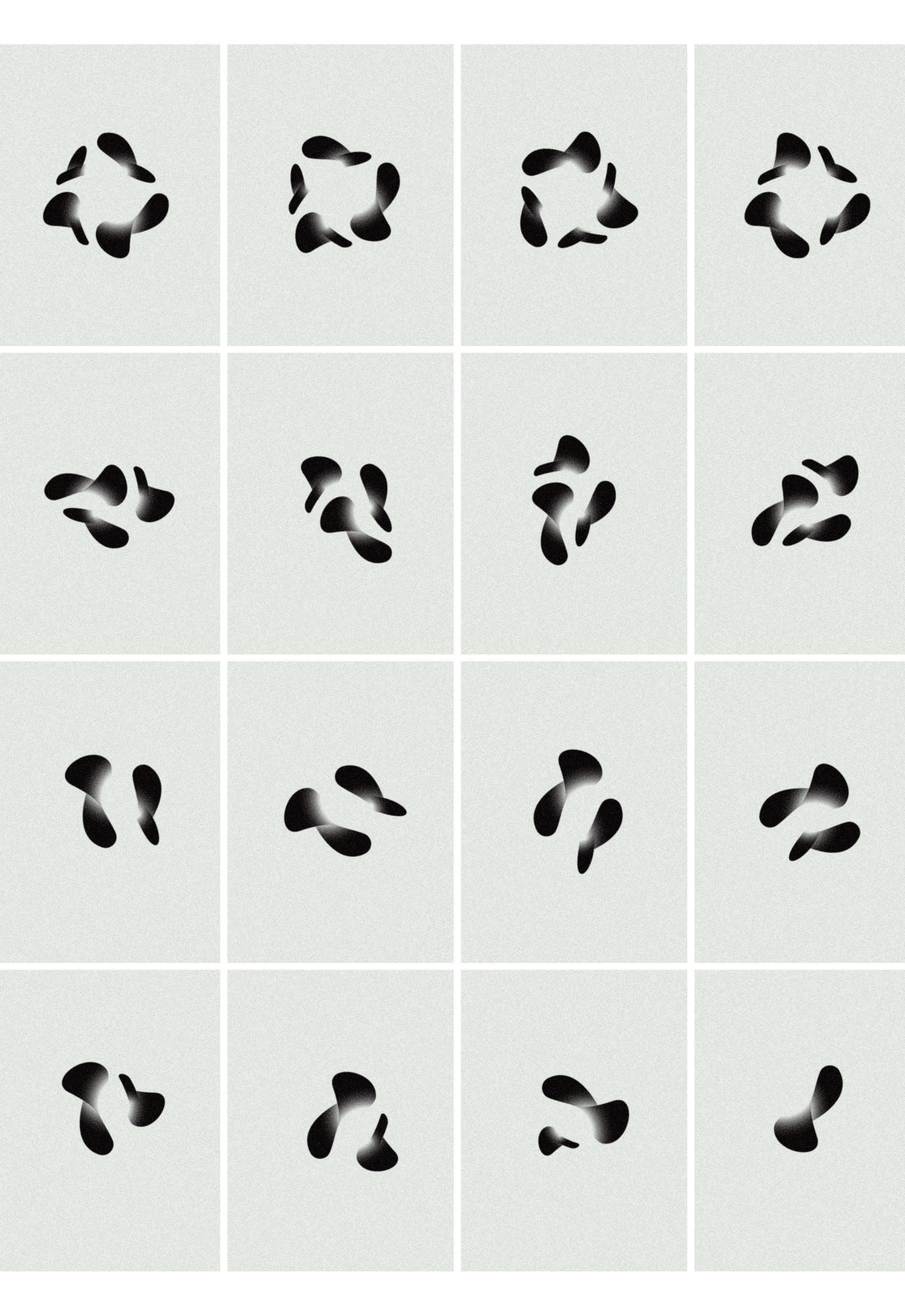
When she was first plucked from her branch, flushed and expecting, her stem was still green from the premature break. He didn’t mind that her toxic sap absent-mindedly excreted onto his calloused palm, and the sweet juice he wanted so desperately to taste remained inside her, patiently. Waiting.
Never had she been more aware of her bareness sitting in his gaze. His soft smile stretched wide enough for her to count the seeds residing in the gaps along his gums, and the residue of whatever fruit he had eaten prior stained the corners of his lips. She blushed at the humorous contrast of his clean cut facade and the mess within his mouth.
He gingerly caressed her velvet skin with his thumb and forefinger, and she struggled to remember a time when she didn’t think so heavily about what she looked like. It was all she could do to not shrivel up inside herself to escape the eyes that were now undressing her. Her nakedness was painfully apparent, and her skin, tender and vulnerable, had ripened to the color of embarrassment and remorse.
The fig tree bloomed with delight, and the branches shook with glee at the snap of her stem. The leaves whispered amongst each other at the scandalous sin they had just witnessed. The figs passed their judgment in their self-righteousness. And as the wasps came and went, they infiltrated and fed on each and every one of the gluttonous hypocrites.
He invited her to her place setting like an offering, and it felt like a luxury to be presented before him, bare in all of her femininity. The tablecloth was freshly bleached. She contrasted the white fabric like a blood clot, and while his head bowed in prayer, it was her who closed her eyes and pleaded.
Eyes wide open, he took a bite, pupils violently dilating as each taste bud experienced her. Grinning like a serpent, he let his fangs sink deeper, and suddenly, she could no longer see. Her vision went black, and she forgot who she was. He was disgustingly ravenous for sweetness, for honey, for the forbidden fruit that was now staining the white cloth.
He pressed into her, nails splitting her flesh open along her stretch marks, and blood dripped out like prune juice. She wanted him to consume every ounce of her, coating his lips, throat and stomach. She longed to live inside of him. She would watch the things pass through him day after day, but be the one thing to remain, rotting in his stomach forever.
I have never lived before this moment. My genesis is within these white linens, and I can’t help but compare the bruises I share with the fabric. My skin looks like hers: wrinkled, mutilated, loved. As he knelt before the altar between her thighs, he drank his communion, and she saw heaven.
Her overripe, dismembered body sat rotting on the dining table he once promised he’d worship her on. She drew scriptures on the canvas with her blood and recited them like poetry. What a beautiful thing, she thought. To be loved until you’re turned into art. He left her seeds scattered like freckles on the table, a concoction of pleasure and pain and regret as he reached for the next fig.
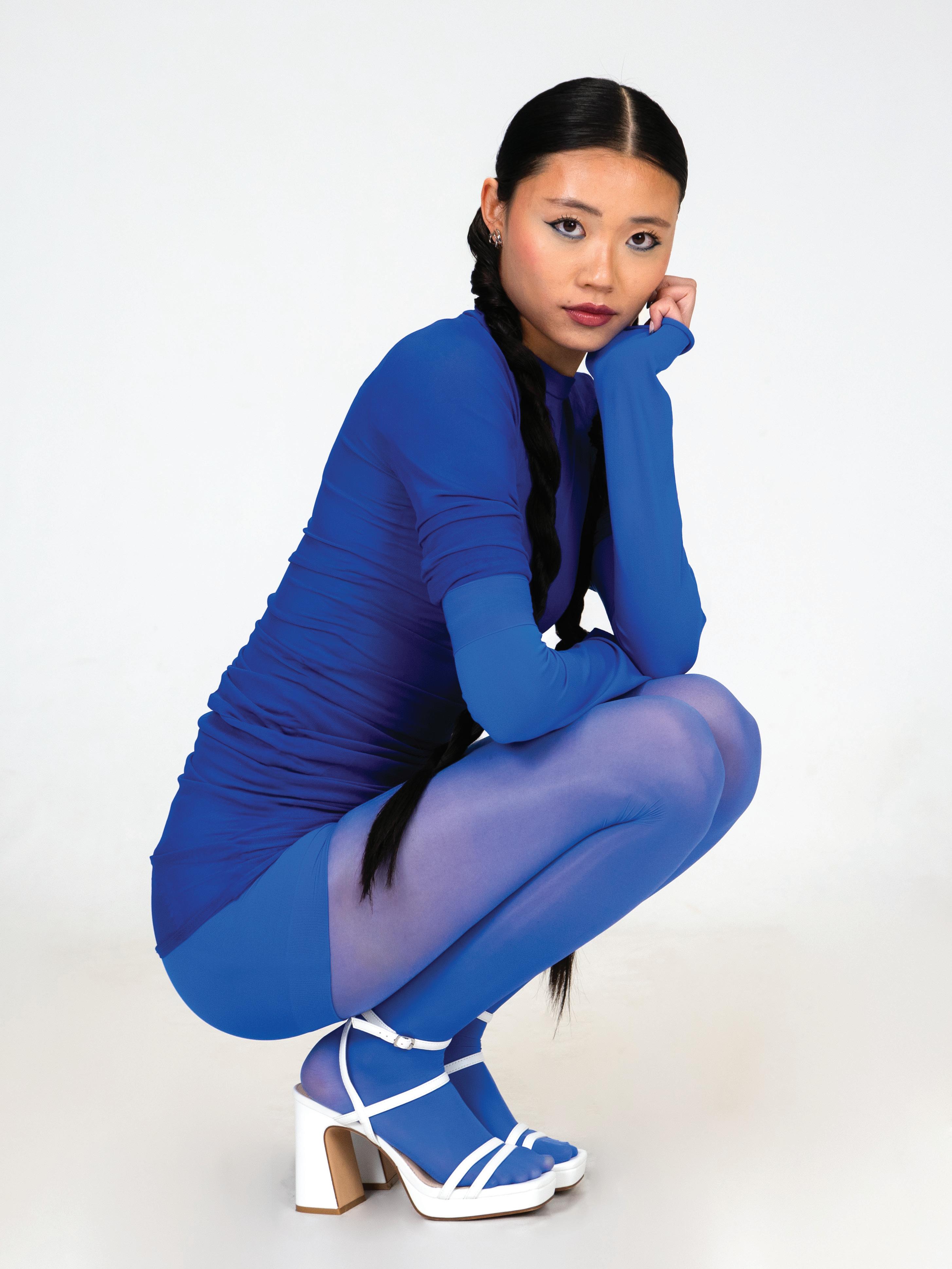

Artist: Sofia Bravo
Museums hold history, but so do the objects we carry with us. The following collection is not made up of traditional masterpieces or extraordinary gems but of the everyday things that have shaped my life. With texture, color and form, these objects have wormed their way into my mind, pushing me to demonstrate their hold through this exhibit. Each piece is a fragment of memory and time, a worn artifact of resilience, love and growing up.
Some objects were kept without a second thought, and others were hidden away after serving their purpose. But all of them tell a narrative. Look closely, and you might find fragments of your own story within them.
Jarritos Bottle Caps, 2014
Aluminum with white, orange, and green acrylic paint (gloss finish)
Of collecting trinkets and memorabilia, the artist’s preferred pastime includes collecting bottle caps of her favorite childhood drink. As a child, she remembers the excitement of sun-drenched afternoons at her grandparents’ house. After a spirited run around the cul-de-sac, an ice-cold Jarritos would be the perfect reward. Her grandfather would pop the vibrant metal cap off with his key, extending it for her to retrieve. This became a small, sweet ritual that echoed with the wonder of youth. The caps lie encased in a clear mason jar, a balance of simplicity and compelling color theory. Jarritos Bottle Caps is participatory, allowing viewers to interact with and touch its materials.
Canon Powershot ELPH-300, 2011
Glass-filled polycarbonate, miscellaneous stickers
Step into the artist’s world — one built around capturing life on camera. She was frequently photographed in candid moments by her aunt, who had a natural talent for preserving the beauty in the everyday. Later, as a teenager, the artist rediscovered the cherished medium, reigniting her passion for photography. Now, the camera is marked with puffy stickers and the gentle influence of her aunt. Canon Powershot ELPH-300 is a vibrant collection of memories from ages 8 to 20. Play around with texture as you feel the slew of multicolored stickers adorning the item. Imagine yourself in the artist’s shoes, fingers carding around the 140-gram medium to capture the most perfect or imperfect moment. Click.
Turquoise Moleskine, 2018
3.5” x 5.5” leather hardcover, faint ruled paper
Diary entries. Melodramatic spews. Love letters. Exposés. Art. From an artist whose long-discovered writing was her passion, the art of journaling undoubtedly took over her teen years. The Moleskine was far more than just a diary — it was a trusted confidante, a silent witness of
her struggles and triumphs. Every page is a moment of vulnerability, a step towards understanding herself in a complicated world. Turquoise Moleskine encapsulates the ups and downs of adolescence and the torment that accompanies an active mind. Through emotion-filled scribbles and countless ripped pages, this exhibit tells stories of love, identity, resilience and what it means to be a 16-year-old girl.
Volleyball Shoes, 2018
Polyester-based fiber, rubber
Art isn’t always beautiful — sometimes it’s beaten up, scraped, peeling and blood-stained. Growing up in a sports-loving family, the artist was no stranger to the world of relentless practices and hard-fought victories. Weekend mornings were spent listening to the sound of squeaking shoes on the gym floor and parents frantically yelling. Each game, she would lace up the white shoes she’d had since the start, ignoring the widening rips and faint stains of blood that marked her vigor. Volleyball Shoes weave together performance and culture. It takes you into the artistry and engineering of the soles that kept the artist engrossed for four years.
Family Picture, 2012 Polyester, emulsion, dye
What does it mean to remember? It was a warm, sunlit day in Santiago, Chile, and the artist and her family paraded around a vineyard. They lined up in rhythmic fashion to take a picture, each sporting a bright smile. The photograph captured not just an image but the echoes of laughter and familiarity. It lies encased in a metal frame, a forever reflection of quiet endearment. Family Picture is a visual journey through color and emotion in Santiago. This piece is a meditation on time and change to a family of four. The metal frame around the film picture invites a sensory experience. But step beyond the frame and examine the gut-wrenching ache of nostalgia.
Closing Note from the Artist:
Thank you for stepping into this exhibit and engaging with the pieces. Each work is a reflection of a personal, emotional and ever-evolving journey of mine. Through each medium, I sought to explore the impact of our physical possessions, inviting you to reflect and possibly see a piece of yourself within these works.
Art, at its core, is about connection. Whether a specific piece resonated with you or you simply observed in passing, I hope this collection sparked something within you.
words SOFIA BRAVO


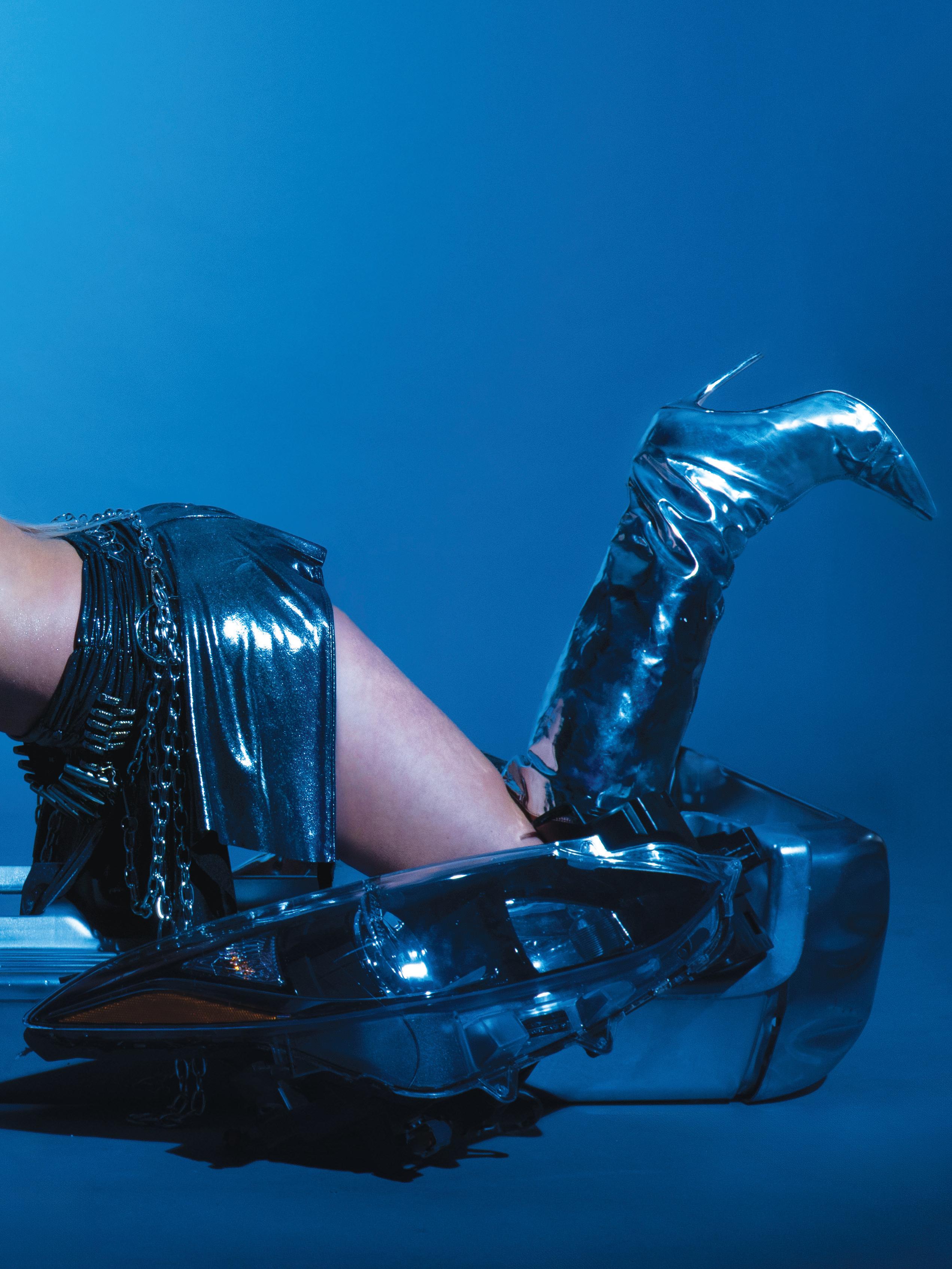



Our identities demand clarity. From a young age, we hear the echo; it tells us to live with passion, choose wisely and become the people we want to be. After all, we only live once. This tantalizing fate of absoluteness is alarming yet motivating. It’s the catalyst for action and the barrier against simplicity. It leads us to create unwavering versions of ourselves — ones free from external influences.
But the notion of an unchanging identity is intimidating, for isolation within the confines of our own selves is a daunting reality. Remaining forever bound to our darkest qualities leads to cynical, hopeless thoughts, worsened by our current circumstances.
A moment in time feels forever plaguing to our core selves. A motivating response to this imaginative black hole is the thought that we can begin anew. Redefine ourselves.
But what if this idealistic rebound was reality?
If I asked about the first five years of your life, you’d struggle to provide a provoking response with accurate recollection. That is because our memories are fleeting; our minds only have the capacity to preserve certain moments in time. We are an ever-changing species, virtually turning into different versions of ourselves throughout our lifetimes. Through love, gain, grief and loss, our identities are not fixed but continually mirrored by our lived realities and the impermanence of our memories.
But what would it look like to reject identity in the traditional sense?
Philosopher David Lewis provides insight into this thought experiment. He rejects the idea of rigidity in identity, promoting the belief that who we are is a manifestation of the parts of ourselves we wish to cultivate. Who we are is really negotiable to who we want to be at any given time. To Lewis, our identity is not an unchanging definition but something that can evolve depending on the state of ourselves we occupy. His philosophy transcends the idea that we are confined to one stage of our life — adopting the freedom of change.
Lewis’s approach frees us from the constraints of strict self-definition, granting us the liberty to adapt and grow without abandoning our core selves. Rather than being fated to a single, enduring version of who we are, we are shaped by the internal forces we navigate and choose to integrate into our external existences.
If this is really true, why are we so stricken by our former selves?
The pulling weights of our pasts offer comfort in the wake of change. We hold on to imbued moments to neglect the present. As we mistake familiarity for stability, we lose the capacity to metamorphose into a greater version of ourselves — a new identity. But if Lewis is right, then letting go of an outdated version of ourselves is not abandonment but growth.
As we encounter uncertainty, we nurture the choice between our earlier selves and rebirth. Human beings sustain the capacity to change over, love again and fall once more. Our lives are not preordained but rather manifestations of our choices, lived out by our realities. We are forever shaping our existences through the delicate balance of who we were, who we are and who we desire to become.
words


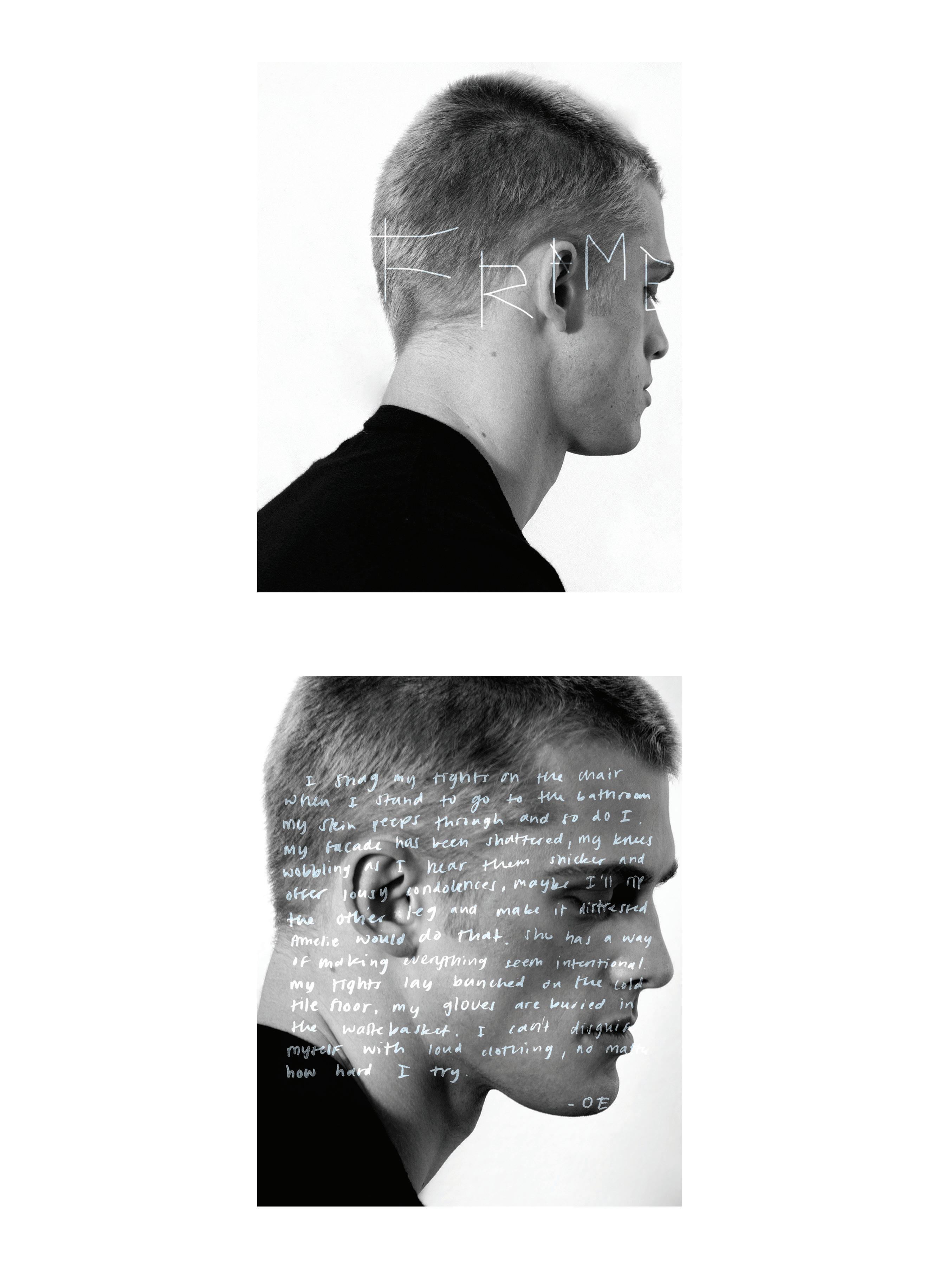
Amelie’s hands are like the rocks that just miss the scrape of the tide. Hard, jagged, toughened by the elements. The nonstop wind. The relentless heat. While other rocks are saved by the sea, these remain stationary; they hold their ground.
Mine I would equate to skipping stones. They’ve been smoothed over by the salt in the water, taken at the ocean’s mercy and spat back when they’ve become burdensome. These stones never hold their own. They never attach to the ground and demand, willfully, that they will not be moved.
I know exactly how she’ll react when I reach across the table at dinner tonight. A glimmer will appear in her eye as she sees my unscathed palms and my untouched manicure. She’ll make a remark to the table, garnering a few chuckles. “I just think it’s funny how…” she’ll begin. I’ll become so consumed by the heat in my cheeks and my need for a retort that I’ll miss the punchline. But I don’t need to hear it to know what it entails. Amelie knows I sit on my hands. She knows the disdain I feel for her backhanded jokes. She knows I’m boiling inside at everyone laughing at my weakness. And unfortunately, she knows I’ll laugh along, like everyone always does, and stay complicit.
Maybe I’ll wear gloves tonight. I’ll shield my tender palms in polka dots. Amelie will definitely point out my unique fashion choice, but at least it’ll prove my autonomy. Maybe it’ll remind her that I actually do have opinions and thoughts. Sure, I don’t always express my dislike like she does. Amelie has never once had a thought she didn’t convey, even if she didn’t do so vocally. Her energy consumes the room. If she feels a way about you, you will know. She’s direct and hard-hitting. Amelie’s opinions don’t rest at the tip of her tongue; they spew out, unconcerned with their reception.
I wish I had Amelie’s rough hands. She earned them through every punch thrown, every door she clawed at until it opened. Nothing has ever stood in her way.
My legs shift as I uncross one leg and cross the other. I can never seem to find a spot and stick with it. Just when I finally stop noticing myself, I do. I wrapped my legs in sheer tights tonight. They’re not long; they’re not expansive. The tights bunch at my heels. My feet are always the ones kicked by others from under the table. Naturally, I apologize. I always apologize.
I thought the tights would give some legitimacy to my foundation. It’s wobbly on its own but bolstered by suffocating sheer nylon. At least, I think. Strength is performative; it’s forced. You have to take big leaps to one day fall into stride. It doesn’t come naturally to me like it does to Amelie.
Her legs are guarded by the rough pleats of her slacks. She came straight from her internship — that’s why she was late. A seat was saved for her in the middle, across from me. Her drink was waiting for her when she arrived. I don’t even know her order, yet I’m her oldest friend. “You know you’ll always be my person.” Then why do her new friends know her better than I do?
I snag my tights on the chair when I stand to go to the bathroom. My skin peeps through, and so do I. My facade has been shattered, my knees wobbling as I hear them snicker and offer lousy condolences. Maybe I’ll rip the other leg and make it distressed. Amelie would do that. She has a way of making everything seem intentional.
My tights lay bunched on the cold tile floor. My gloves are buried in the wastebasket. I can’t disguise myself with loud clothing, no matter how hard I try.
words OLIVIA EVANS
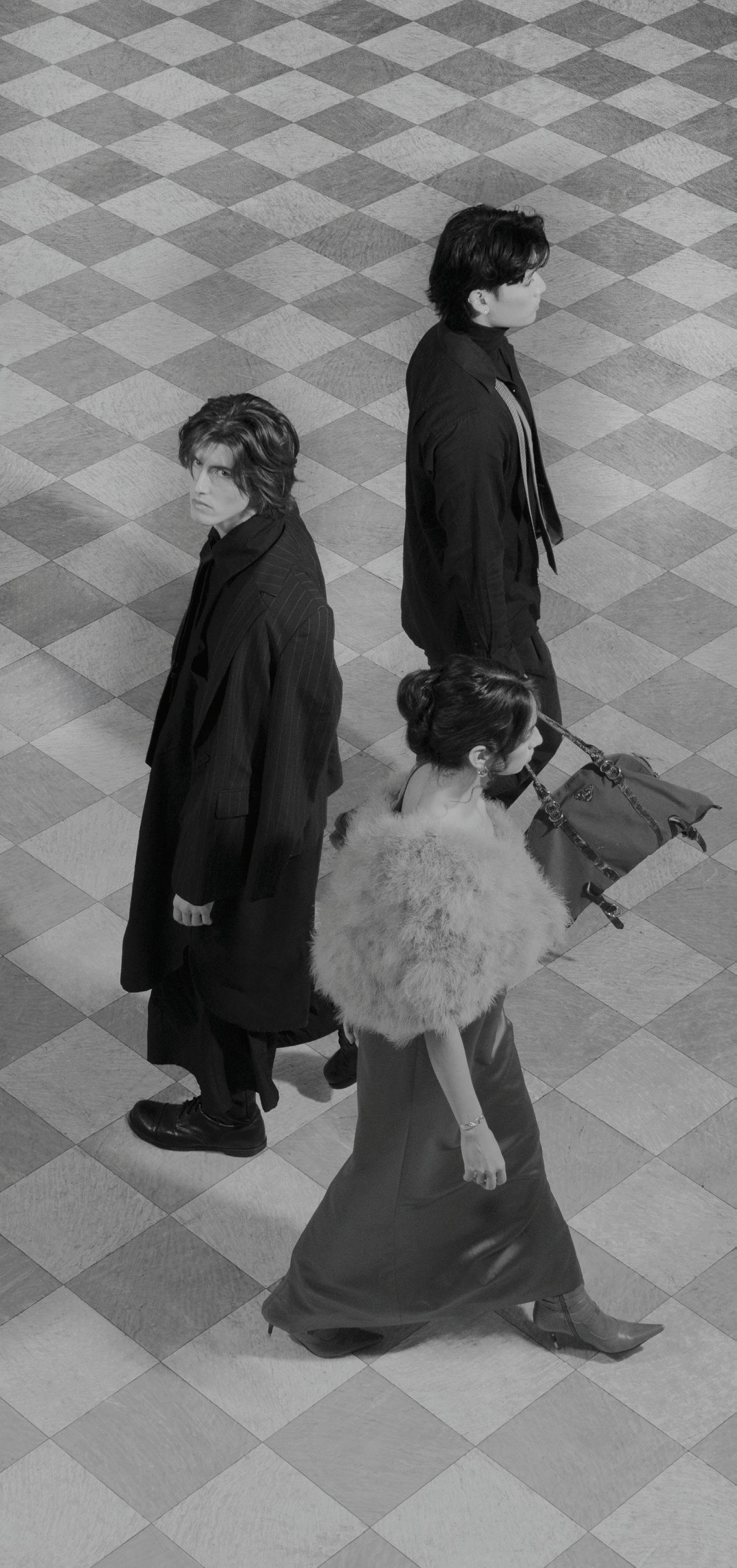
Style in motion — unbound, unfiltered and ever-evolving.
A space where expression takes shape without rules or limits.


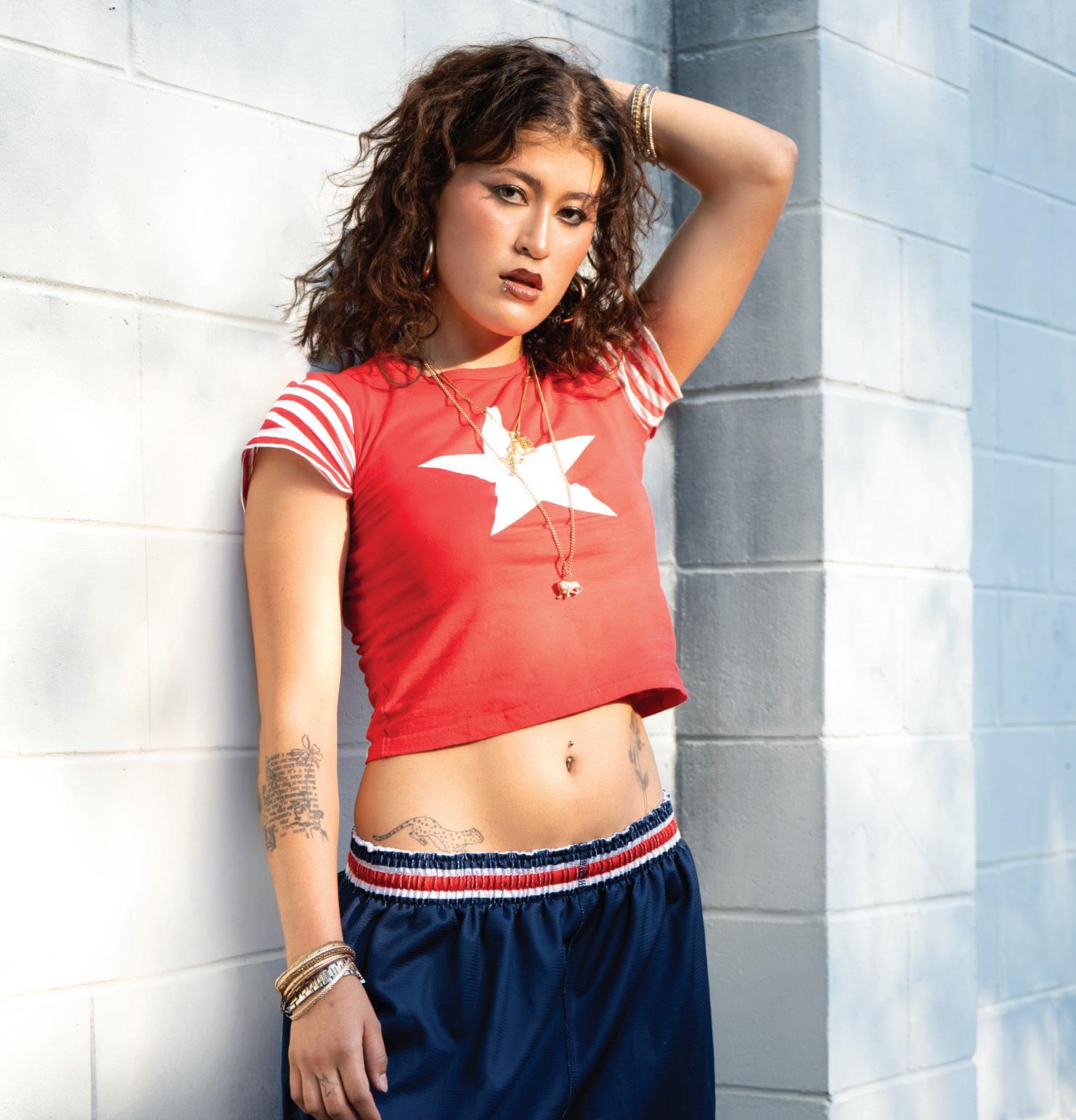

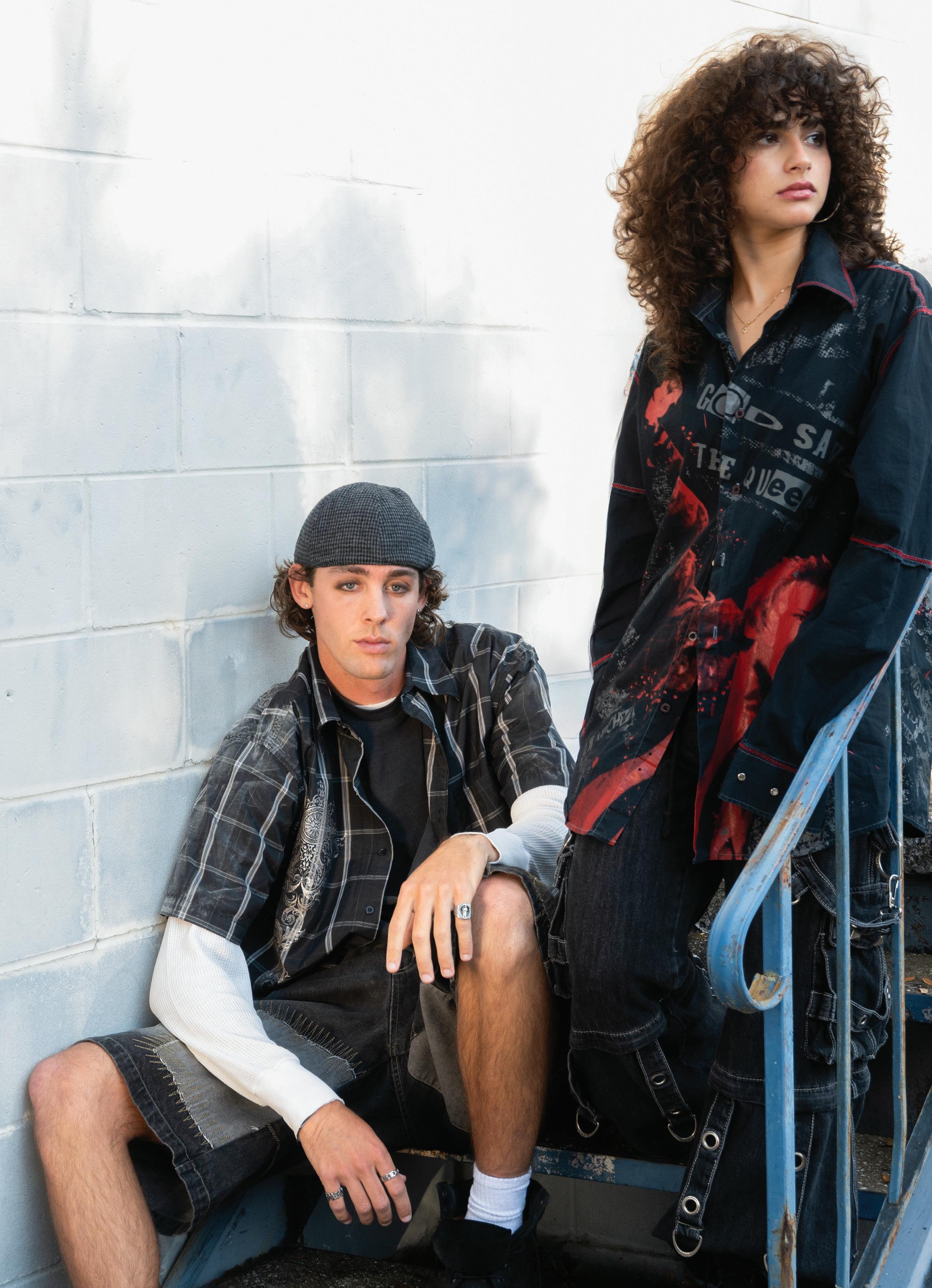


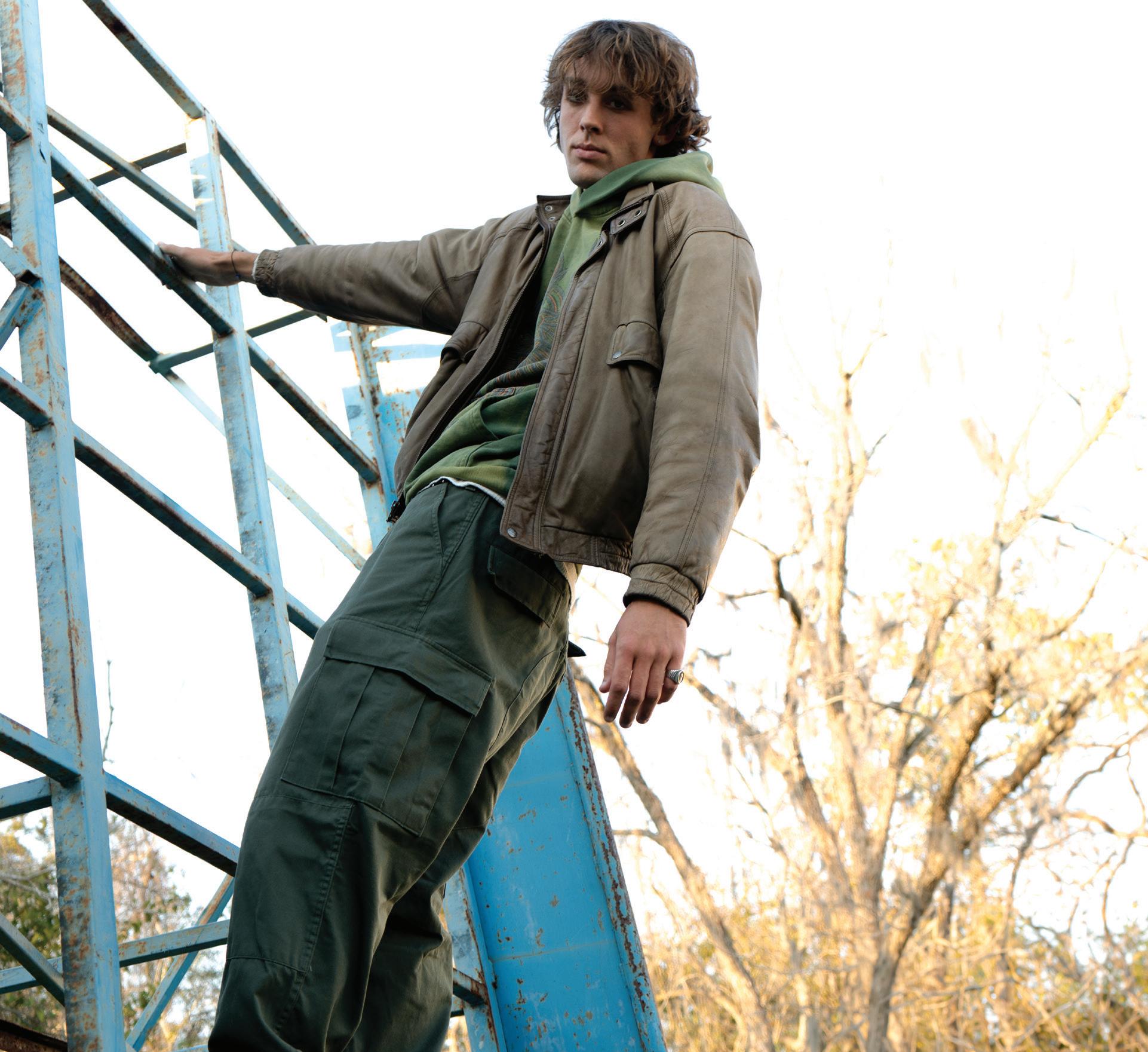

I bought my first fashion magazine off an airport newsstand when I was eight years old. It was a glossy, pages-still-slightly-sticky edition of Teen Vogue, which I regarded with the highest credibility. I still remember the “Spring Style” spread, adorned with coolly coordinated outfits that captured the abstract energy of springtime. All I wanted to do was put together looks that felt as perfectly curated as the fashion spread I fell so in love with.
But much to the death of my Anna Wintourian daydreams, I’m still waiting for the day I become stylish.
At the ripe age of 19, I still find myself overwhelmed by the thought of shopping. I can never tell the difference between trendy and timeless, and my day-to-day outfits rotate between athleisure and some variation of a trendy top with jeans. My social media drowns in an endless rotation of outfit “aesthetics” that seem carefully chosen, all the way down to the ruffles of a sock or the color of a belt buckle. Nothing I wear bears any sort of aesthetic appeal. Or at least, I am led to believe this.
The only thing I’ve noticed in my quest for style is my attachment to particular pieces — the items I find myself coming back to over and over again, regardless of the chapter of my life.
I. The Planet Necklace
It’s exactly what you think it is: a string of colorful orbs reflecting the solar system’s alignment. I bought this necklace when I was eight and wore it once. After recognizing the necklace’s similarity to a planetary mobile, however, I deemed it too “babyish” within weeks of purchasing it and shoved it in a bedside drawer.
I ended up digging it out almost a decade later, and I’ve been wearing it nearly once a week ever since. The necklace physically represents the eight planets, with colors and size differences that create an awkward, misshapen pattern. Some individuals register this pattern of planetary orbit and point it out to me. Others don’t. I rarely wonder whether they interpret it as weird or otherwise.
I get a distinct sense of satisfaction whenever I tell people that I wear my planet necklace because “I’m a nerd,” as the self-deprecation holds an element of truth. I wear the jewelry not because I’m a fan of any of its particular design characteristics but rather for its intentionality. When you realize it’s a nod to the solar system, the irregularities become purposeful and, in my opinion, far more beautiful.
II. The Only Top I’ve Successfully Thrifted
Being a style novice doesn’t lend itself well to secondhand shopping either. I’ve notoriously struggled with the art of thrifting: sifting through racks of tees with little to no avail. Yet, aside from a collection of mildly ironic shirts I’ve amassed, a single lacy Victoria’s Secret tank top has found its way into my wardrobe rotation.
I should clarify that while I was technically “thrifting” when the tank was discovered, it was a close friend of mine who pointed out the top to me instead, like how a proud father might hook a fish and then invite their young child to reel it in. She allowed me to take the unsolicited credit for the find. She also noted the slightly-too-loose fit and resolved to tailor it — and I’ve worn it the same way ever since.
The top is flattering and feminine, yet uniquely versatile, made in part by the intricate sewing pattern my friend used. I enjoy giving inquirers a 360-degree spin in this top, purely to explain the one-of-a-kind hemming.
III. The Black Knee-Highs
I never previously understood people who fixated on footwear, but clearly, I just hadn’t fallen in love with a pair of kicks like I did with my Steve Madden black knee-high boots. Sleek, durable and made to enhance almost any outfit, the boots are a source of elevation — to both my height and personal style.
Though I feel like I have the fashion sense of an out-of-touch mother, I feel the slightest bit fashionable when I choose to accentuate my look with my knee-highs. I’d wear them in the summer, proudly.
IV. The Latvian Seven-Day Ring
Adorned with seven ancient pagan symbols of Latvian idealism, the silver band jingles and jangles upon the slightest wrist movement — a sort of nuisance that’s somehow charming to the right individual. The ring is silver, which has never been my metal of choice, but the basic standard against mixing metals is only ever overruled by this personal jewelry staple.
The sing-song jingle of the ring enhances the attention I receive from close friends and complete strangers alike. I embrace any opportunity to tell others about the importance of the chiming ring charms. I cite a history of embracing female fertility and good health, allowing a small part of my heritage to bear itself on my right ring finger.
Personal style is a statement; it is a reflection of character detailed in the lacing of your sneakers and the ribbons in your hair, or the lack thereof. The pieces I wear, however unrelated or inconsistently aesthetic they may be, tell stories.
And you can tell me if this is style or not, but I sure as hell think it is.
words LAILA MAYFIELD
The man sat down, running his arms down the white arms of the little blue bench. He visited the bench sometimes after work, taking a much-needed moment to himself after long work days. He would sit for a moment, throw a pebble into the pond, and then walk back to his nearby apartment.
The man was one of many neighbors who came and went. A woman with a book. A boy with a dog. A man who sat alone, quiet, until one day, he wasn’t.
A lady, unfamiliar to the bench, plopped onto the wood at the man’s side. In her company, the man smiled more and sat longer, and the weight of his presence lingered even after he left.
Seasons passed, and the lady quickly became the man’s companion for his evenings on the bench. One spring day, the man asked the lady to sit and close her eyes. He walked away, leaning against a tree, watching as she fidgeted and waited, letting her think he was off grabbing something far away. After a few minutes, he returned and knelt in front of her.
“My lady, would you make me the happiest man in the world and be my wife?”
She gasped. She laughed. She cried. And she said yes. Then, they left together, hand in hand.
Leaves changed, the lady’s one ring became two, and abruptly, the pair was nowhere to be found, never stopping by to rest or chat.
Then, one day, the man came alone. Where was his lady? It had been too long; had something happened?
He ran a hand along the bench’s worn wood, and then he lifted the bench up and placed it in his car.
The bench shuddered with each pothole, its slats rattling like wind chimes in a storm. The air smelled of hot asphalt, of movement, of something ending and beginning all at once.
When the man set it down, he took in the bench at his home: a blue house with white shutters. A perfect match.
Later, the man returned with the lady. She gasped, running to the bench and laughing.
“You brought it home?”
“For our first anniversary,” the man beamed.
Now, instead of strangers coming and going, the bench stood strong for the sweethearts. And that was even better.
The man and lady visited the bench every evening, chattering about their day and watching the sky change colors. The man even gave the bench a fresh coat of paint.
One day, they came with someone new – a baby, wrapped in pink.
This was odd. The baby was too small to sit. Too tiny to swing its legs. Too wiggly. Surely, the baby would not return.
But the baby did return. The baby’s cries rose sharp and sudden, not the sounds she should make while relaxing on a bench. How could anyone cry with the man and lady nearby? But soon, she grew. She walked.
She sat. She played with bubbles and caught lizards in the cracks of the bench. And just when she started to grow on the bench, another baby arrived.
While the lady and man were busy with the baby, the little girl still came, her laughter spilling into the yard like sunlight. She sang as she ran, spun until she was dizzyleaped from the swings with wild abandon. The boy, softer in his steps, quieter in his joy, followed close behind, his small feet landing where hers had just been. Then, one day, a yellow dog arrived, curling into the shade beneath the bench, safe from eager hands and endless energy.
Years passed, each pulling the girl farther from the bench. She grew tall, then taller still. One day, the girl arrived in a cap and gown, and the bench understood: the girl would leave.
And she did.
The yellow dog turned white with age. The boy stayed inside. The lady traveled far. The man worked late. One day, the yellow dog was laid to rest beneath the bench, and the bench felt lonely for the first time.
The bench sat empty, with no swinging legs or uncontrollable laughter. The sun dried its paint; the rain softened its wood. Silence settled on the once lively yard.
Then, the girl returned, and she was somehow quite different, yet the same as she ever was. Clearly, she was here to say goodbye.
But she didn’t.
She lifted the bench, careful with its fragile frame, and set it in her truck. This drive was long, the wind tugging at its worn slats. Was this the final journey, a last taste of freedom before being left behind?
Instead, when the girl set it down, the bench sat on the porch of a house.
“This is it, your new home,” the girl said, brushing dust from its arms. “It’s not much, but it’s mine.”
The bench took in the little yellow house, its flowers and bright pink wreath. A new home. But what of the old one?
“It’s lovely,” said a neighbor, admiring the bench. More voices followed, pausing to chat, to laugh, to sit.
Then, the man and lady arrived, and the boy. The girl and her people had a party. They danced between the house and the yard, and the bench was filled with warmth and laughter again.
The bench had thought its time was over, that it had been forgotten. But here it was, sitting proudly on the porch of the girl’s home, surrounded by family and love once again.
The girl smiled and ran her arms down the white arms of the little blue bench – a familiar motion. She smiled broadly, remembering the lifetime they had shared.
“This just wouldn’t be home without you,” she said.
And the bench knew. It was, indeed, home.
words GINGER KOEHLER








The law of conservation of energy dictates that energy is not created nor destroyed, only changed. It’s a law of nature, unchanging and absolute. Everything changes from one to another, transforming to manipulate our realities. Food, water, love and death alike blend together in the eternal dance of life.
Consider the leopard. A cub is born, a mewling ball of fur on the jungle floor, blind in its youth. Its first meal is its mother’s milk, the blood and muscle of a recent hunt metabolized into thick sustenance. The cub drinks with its siblings, scrambling on the wet earth before time molds them into hunters.
Older now, fed by the flesh of unsuspecting victims, the speckled teenager slinks across crunching leaves as her first hunt begins. Fangs clamp on the neck of her prey, and somewhere a mother wails at the loss of her child. As hot blood drenches our leopard’s muzzle, we are reminded of nature’s cold immorality. It’s never personal, this endless fight for survival. One life ends to sustain another, and the law is upheld.
She mates and sleeps and stalks, her coat glistening in the dappled light. Her mate is nearby, prowling the jungle’s edge as a new age of small bodies rolls around in the falling leaves. The law dictates that some fat mammal will feed this new family, a sacrifice for the newest generation. The cubs are the product of their mother’s sacrifice, and yet they are still their own.
Our leopard has seen the moon glow and darken more times than she can count, but time is no longer on her side. The night she falls is like every other, the moon beaming as her body grows cold in the brush. The trees watch with murmured disinterest as the wind prods at her fur. They watched her first clumsy steps among their fallen leaves, and they braced themselves when her sharpening claws dug into their bark as she learned to climb. “Her grandmother learned quicker,” they muttered amongst themselves. Time has made them indifferent to the individual.
Circling figures find her corpse through the tree line and claim her rotting flesh as their own. Time will sink her bones into the ground, breaking them down to feed the earth itself. Her death is not sad, nor is it an injustice. It is simply the law.
Humanity has yet to reconcile with the inevitability of death. We are a species dedicated to our own longevity, however futile this may be. Yet just as the law confirms our eventual demise, it also guarantees that our lives will be molded by experience. Our finite existence is what gives us meaning, reality made richer by relationships. True, the human presence is a short one, but is that not the beauty of it? We are placed amongst the leaves with the end in sight, and yet the law propels us closer to one another, driven by love and death in the eternal dance.
The law of conservation of energy states that all energy is transformed, not created nor destroyed. Time is the executor of the law; it is the inescapable reality that will outlast all things. We cannot outrun the steady movement forward, skin sagging with age as the world turns on itself.
Time, the impartial judge, will return us to everything.
words HAILEY INDIGO


Memory breathes if you allow it to live.

We dig at our buried memories in an attempt to fill a void that we feel.
Looking into my mirror, there is a different face staring back at me. Her features are recognizable and real, yet distant and unreachable. Her eyes swell with warmth and admiration. I still recognize the space between me and the reflection in the mirror.
Her visage lingers within me, begging for recognition. A familiar song comes on in the grocery store, and I’m filled with nostalgia. I see her in every mundane task I perform. Her presence is in the air on a crisp winter day as I feel the sun’s warmth, drawing an involuntary smile to my face. She is in my family, woven into each of us in our own way, and carried forward in the stories we tell and the love we share.
When I see her gaze reflected in the mirror, I’m reminded of all of those who came before. I’m reminded of the lives that laid the groundwork for all of the beauty and love woven into our own. Small pieces of their souls forever remain on this earth as we preserve their memories. One day, our lives will be reduced to pieces of ourselves, too — glowing through those who come after us. We are born, we live, we love and then we die. However, we are never truly gone.
Grief acknowledges the physical loss of a person, but it can never grasp the loss of identity that we feel in their absence. But memory is fluid and alive. With loss, we dig at our buried memories in an attempt to fill a void that we feel. Our questions linger and emptiness persists. If we instead open our hearts to love and new experiences, we can feel closer to those that we’ve lost than ever before. Memory breathes if you allow it to live.
I hear my grandfather’s voice as I roam the streets of Italy, saying “La dolce vita, carissima Sofia.” Beauty, art and elegance pour out of every doorway in Florence, and as I walk down the cobblestones, I imagine him walking down the same road and admiring this world’s art just as I am. He loved every aspect of his home country: the culture, the
beauty and symbolism in the art and the people. He spoke of Italy with such passion and vibrance that those around him couldn’t help but be captivated by “la passione di Italia.”
Walking down the same streets, I feel touched by his soul. The city hums with stories — a thousand unspoken connections woven into its walls. Countless people have walked down the same road, and many have reminisced and felt touched by the presence of others while taking their stroll. If we slow down and open our hearts to the presence, we will feel it.
When our souls grace this planet, we leave traces of our presence upon everything we encounter. We stand in the same places that others have stood, and fragments of familiarity linger in our conversations. If you decide to acknowledge it, the ghost of love is eternal. It warms your breakfast table as you sit with your loved ones over coffee; it reassures you when you accomplish goals and milestones and it comforts you when life presents you with its hurdles. You hear it in your friends’ laughter and see the ghost in all of the beauty of this world. We are a mosaic of the love we have experienced.
Now, I look into the mirror, greeted by a multitude of familiar faces, their intimate, loving faces that have shaped me, their presence as real as my own. It is almost as if I could extend my hand to meet theirs, but I don’t need to; their presence is enough. Our time is fleeting, but I am at peace knowing our essence lingers long after we are gone. Opening up our hearts allows memories to shine through us and grace the presence of our lives once again.
I see my mother in my reflection, in the spaces between moments and in the love that lingers. We live on in those who remember, in the love we leave behind.
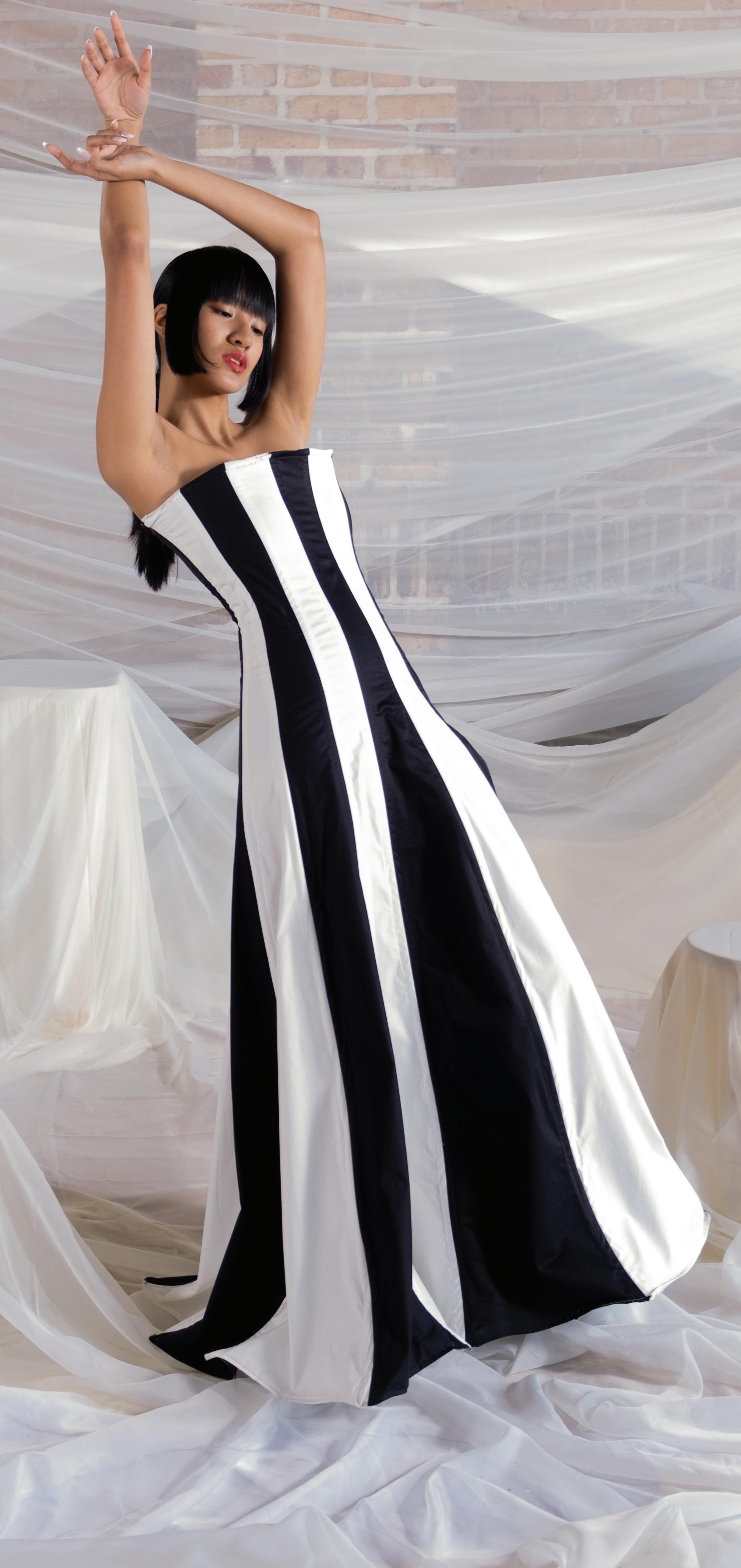
Reverie: An original collection that explores time through fabric, texture and form — where softness meets structure, fleeting moments dissolve into chaos and beauty lingers in what remains.



I grew up hunched over a loud sewing machine, working on a denim skirt or a Christmas-themed pillow cover. I wasn’t more than seven when I first began sewing, taking a doubled thread and making a knot as my grandmother taught me. Every day was a new lesson, and I was desperate to learn. Half of sewing is ironing, she’d say, and the beige-colored board would host a warm iron once again. There was always a trick to pick up, a book to highlight, a pattern to size. I came to realize that sewing is forgiving, but only until you begin to cut.
Most people assume that sewing is an act of finality. They worry that they will pick up a needle and make some irreversible change that renders their shirt unwearable. They forget the seam ripper, a sharp handheld tool intended to remove unwanted seams from a project. In reality, any mistake that a seamstress makes can be completely undone with patience and this common tool. That is, any mistake except a miscut.
Measure twice, cut once. When a seamstress picks up the scissors, she is making a decision that cannot be undone with the seam ripper. Any line of stitching can be sewn and unsewn as many times as need be, but scissors suggest a more important decision. When cutting pattern pieces, a seamstress needs to mark her guidelines clearly, ensuring a correct cut. This is the only true way a sewing project can be ruined, through a swift decision to make a permanent change. If you ask me, you should measure three times.
After hearing the seriousness of cutting out the pieces, it can be scary to begin. Despite this, nothing can be made without the first cut. A person should test their project, but eventually, it will be time to sew. Just as the making of a beautiful dress comes with patience and clever decisions, a beautiful life comes with a similar decision-making process.
The seamstress is constantly confronted with choices, taking bits of extra fabric and testing different stitch lengths, comparing zigzag and straight, experimenting with craftsmanship. Many decisions are tailoring choices, designed to provide a frame of reference for what fits. This could be a fashion sense, or something different, like a favorite study spot or a hobby. These can be changed with little to no consequences, able to be varied endlessly to open life to more experiences. Other decisions are made less often and with more weight. This is when you cut.
My grandmother made countless projects in her time, even sewing my aunt’s wedding dress; she owned every book on sewing ever published. She knew what felt like everything, but even she didn’t know the right cut for another seamstress. My grandmother would always give her advice, but at the end she’d say: “This is your project.”
words RACHEL MISH
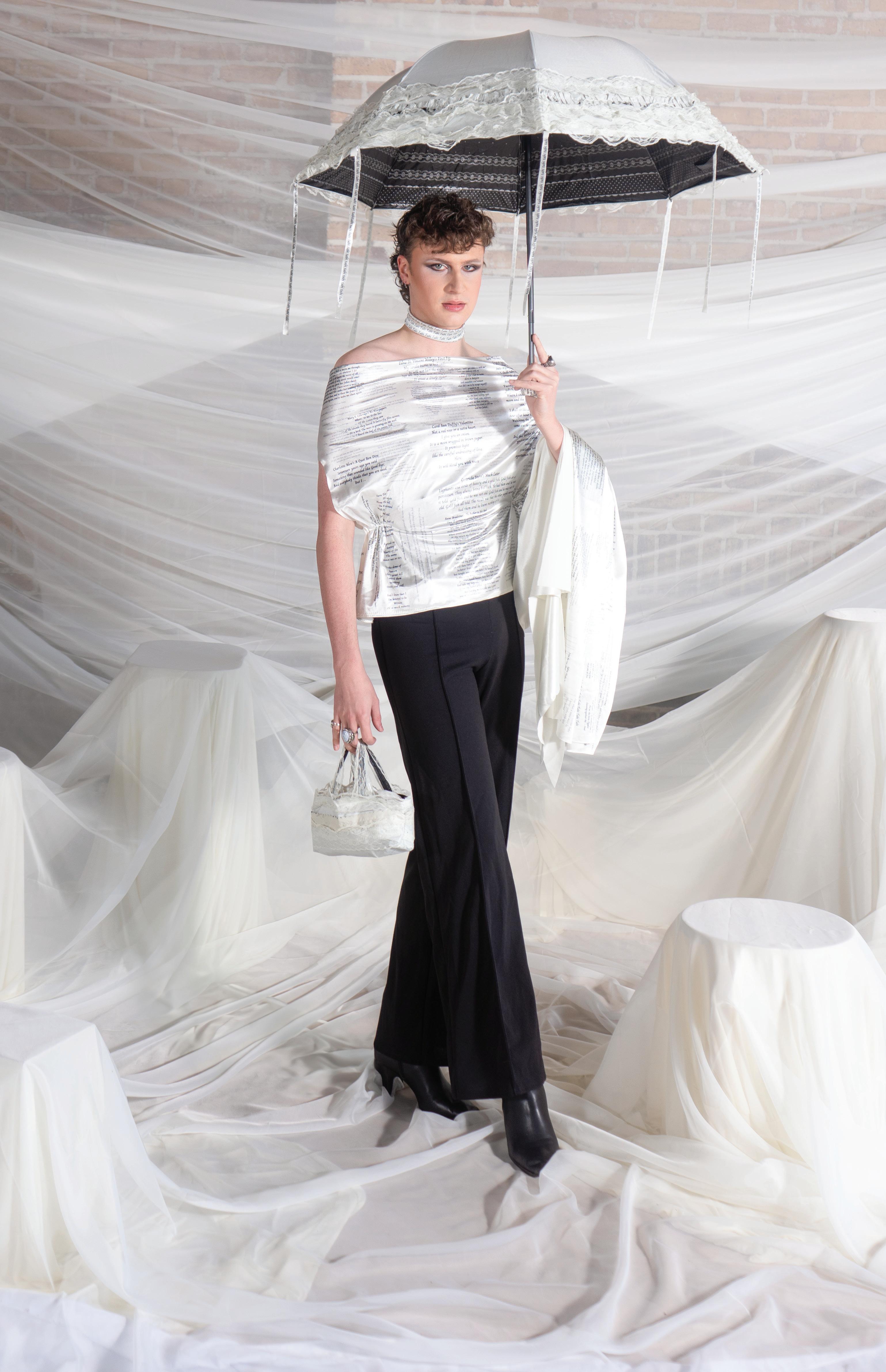

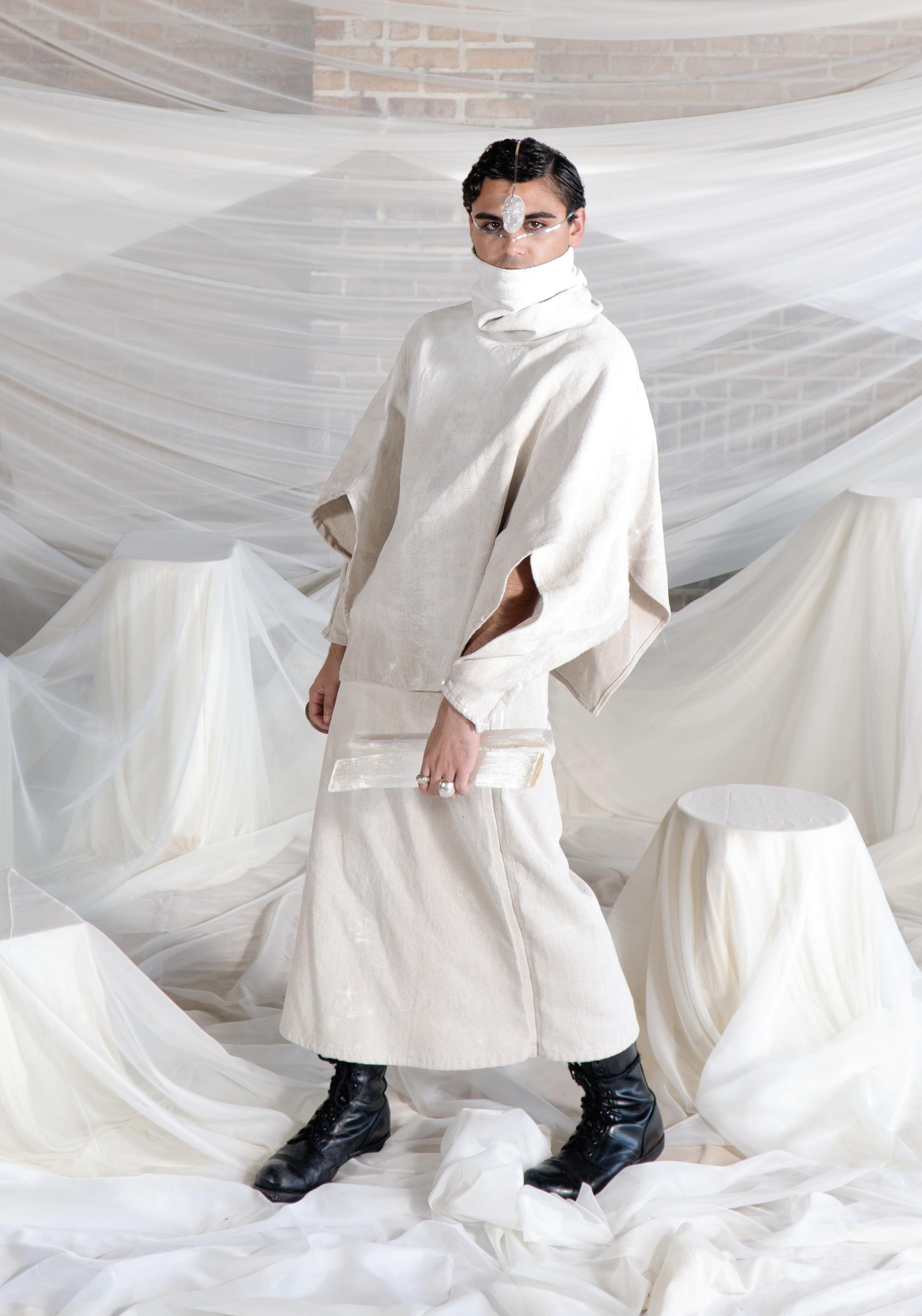
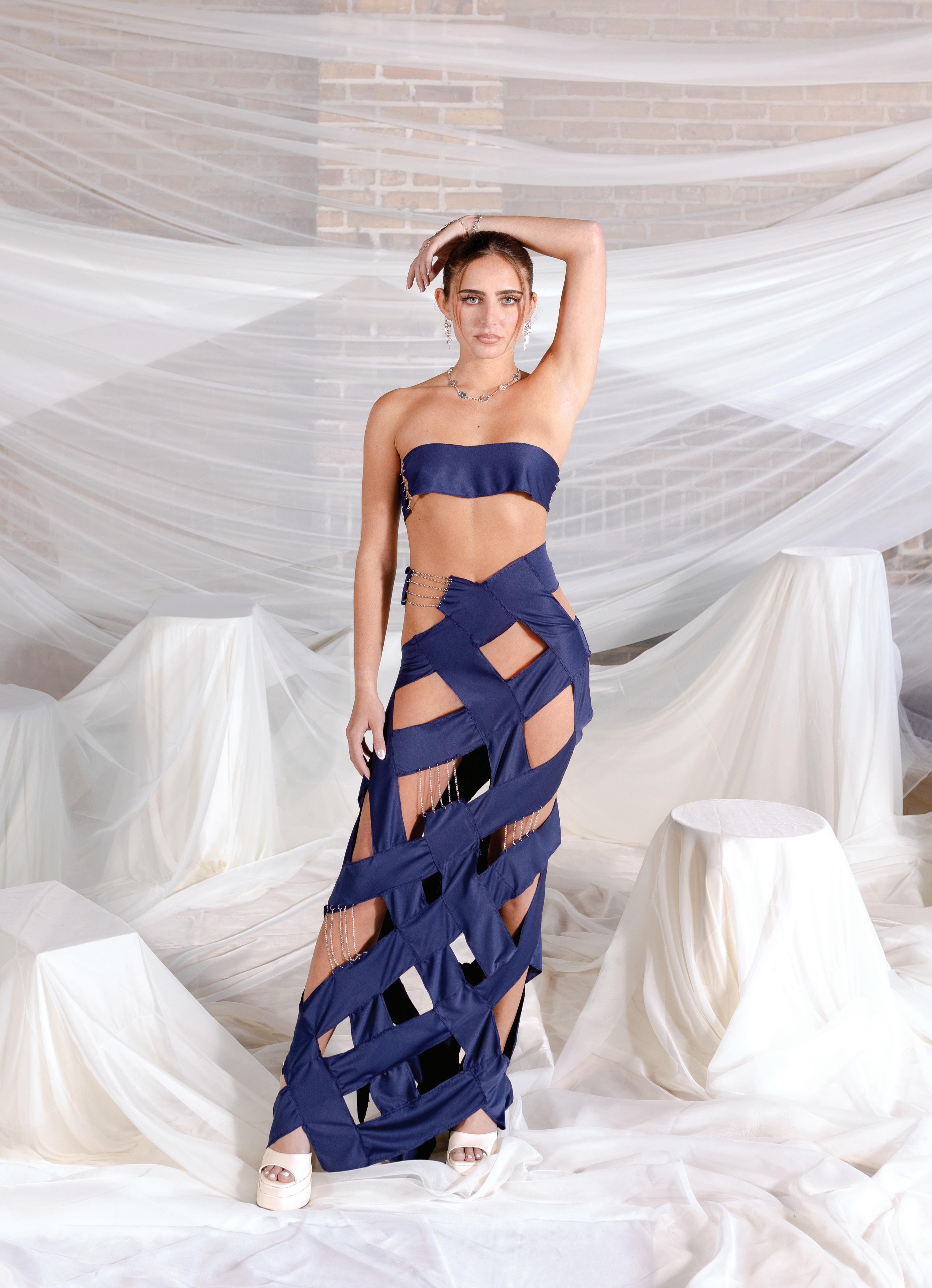


White linen. Starchy and delicate. Her dress hung lightly, brushing her knees as she bent down. A basket filled with cotton.
White cotton. Over and over, again and again, she reached into the basket. One corner at a time, she pinned the fabric to the line. Rows and rows. The line reached forward and backward, round and round.
White sheets gently billowing in the wind. They brush past her as she picks up the basket to secure the next.
The softness of her movement, tempered by the innocent warmth clinging to her hip. A grounding weight. Anchored and anchoring.
She pauses, drops the pins. Sets down the basket. She looks down at the quiet weight. Her life stared back at her.
I awoke with a distinct sadness and relief. How does one make sense of a life that they do not want but dream of?
Last night I was warm and tender. I was light. There was a singularity, a simplicity to her. She was tethered — reverently committed. A life unquestionably lived. For and with another.
Such a pretty dream, now heavy with the weight of waking life, the need to make sense. To be for something beyond myself. Sometimes, I wish I were burdened.
Dreams are revealing. They splay us open, lay us bare and then dress us up. There’s an explicitness that is made almost crude. Cheekily disorienting. Teasing harmony, keeping the illicit desire elusive. I pitied her, but I was jealous. Like Janus, staring in both directions at once. One face turned toward a surrender, the other toward possibility.
I remember the coolness of the thinly veiled sheets grazing my shoulders, cheeks and thighs. I still feel the weight. The pressure on the crook of my hip. The heaviness resting over my heart.
There’s a desperation which we demand from our dreams. Some doorway to our desires. We beg them to unravel and show us who we are. They underlie fantasies which structure the life we live. Our dreams fulfill the wishes we don’t know how to wish for. She visited me often for some time. The weight is always with her. It was a calming reverie that returned when I was most distressed. It remained confusing. It was all there, yet it remained inaccessible. Dreams don’t promise unity — they reveal disunity.
There’s something so exhausting about always doing. The responsibility of it. The expectations and oughts. Sometimes I have this craving to be done. Have it be thrust upon me.
In my dream, it was a life lived for me. I lived out a fantasy of submission. The dream embodied the desire.
We do this all the time, though. Submitting to some life. Always grounded, guided. Maybe you just don’t know who or what you’re living for. That’s the thing about fantasy — you’re always already living it.
You’re never just doing it in your dreams. It’s difficult to confront that it’s all there in everything you’ve done.
I just want to know what it’s being done for. What I am being done for.
Maybe one day she will show me. Maybe someday I’ll listen.
words NAINA CHAUHAN
Dreams are revealing. They splay us open, lay us bare and then dress us up.
A life unquestionably lived. For and with another.
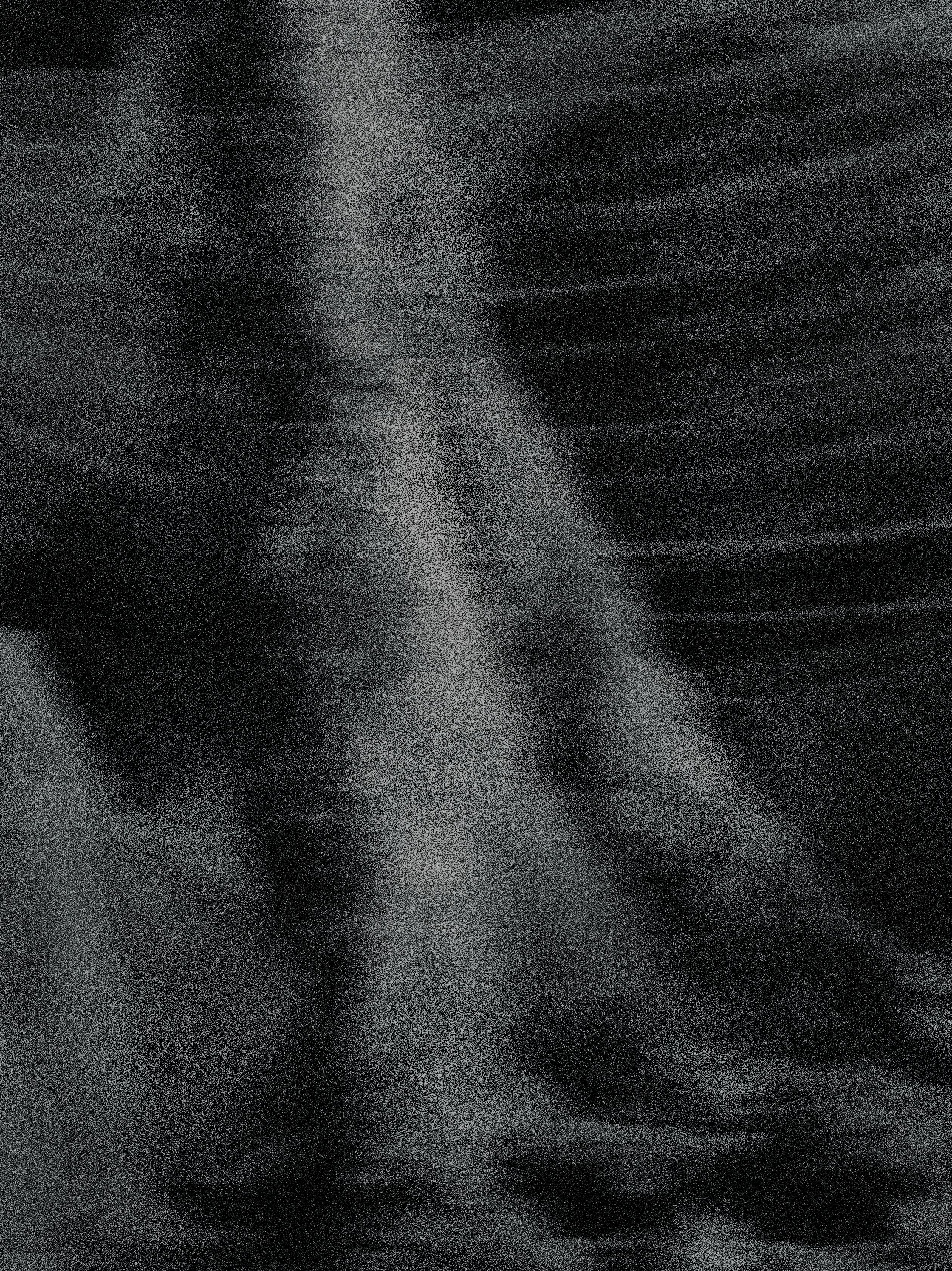
starchy delicate tethered reverently committed
Our dreams fulfill the wishes we don’t know how to wish for.
There’s a desperation which we demand from our dreams. Some doorway to our desires. We beg them to unravel and show us who we are. They underlie fantasies which structure the life we live. Our dreams fulfill the wishes we don’t know how to wish for.
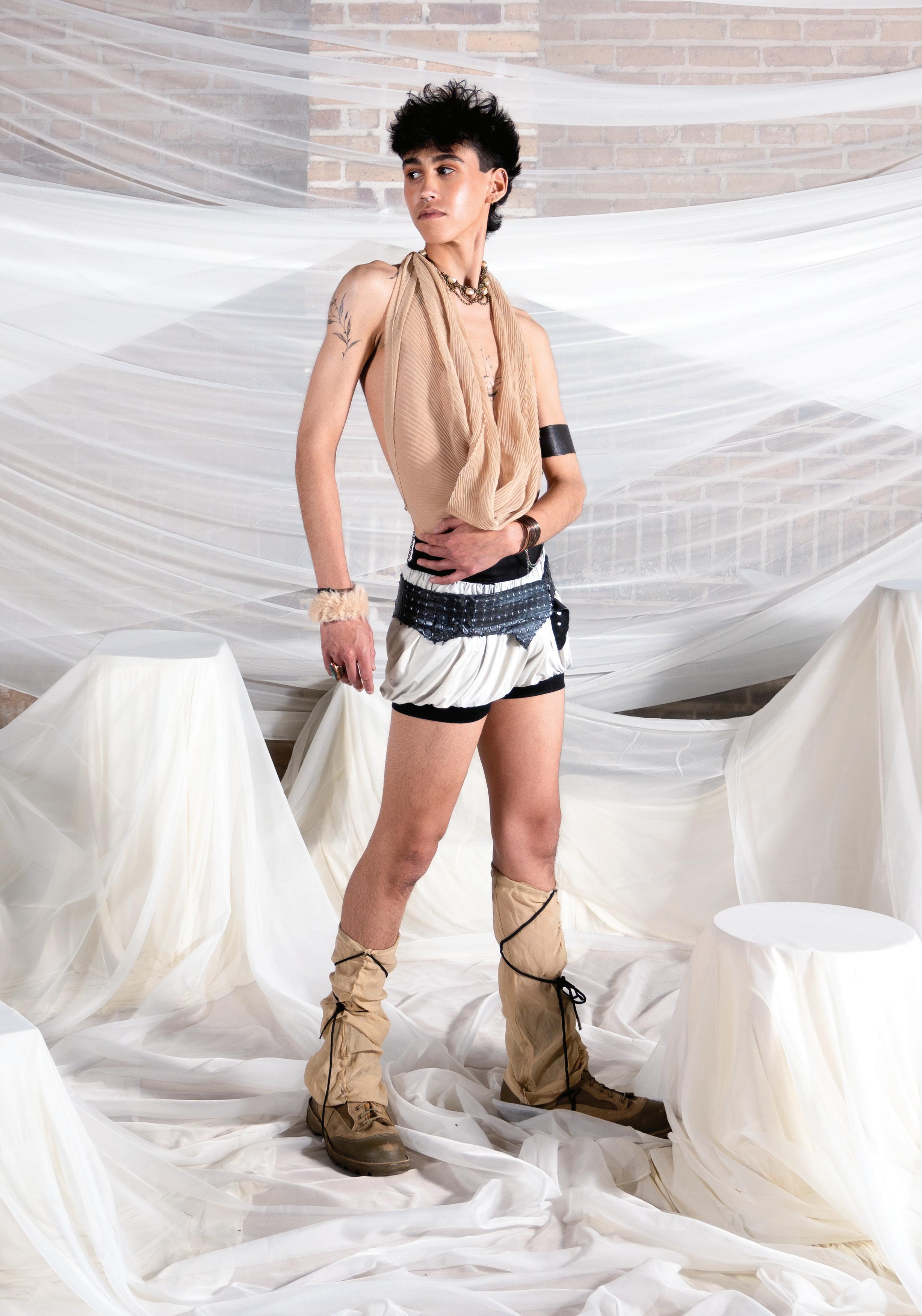

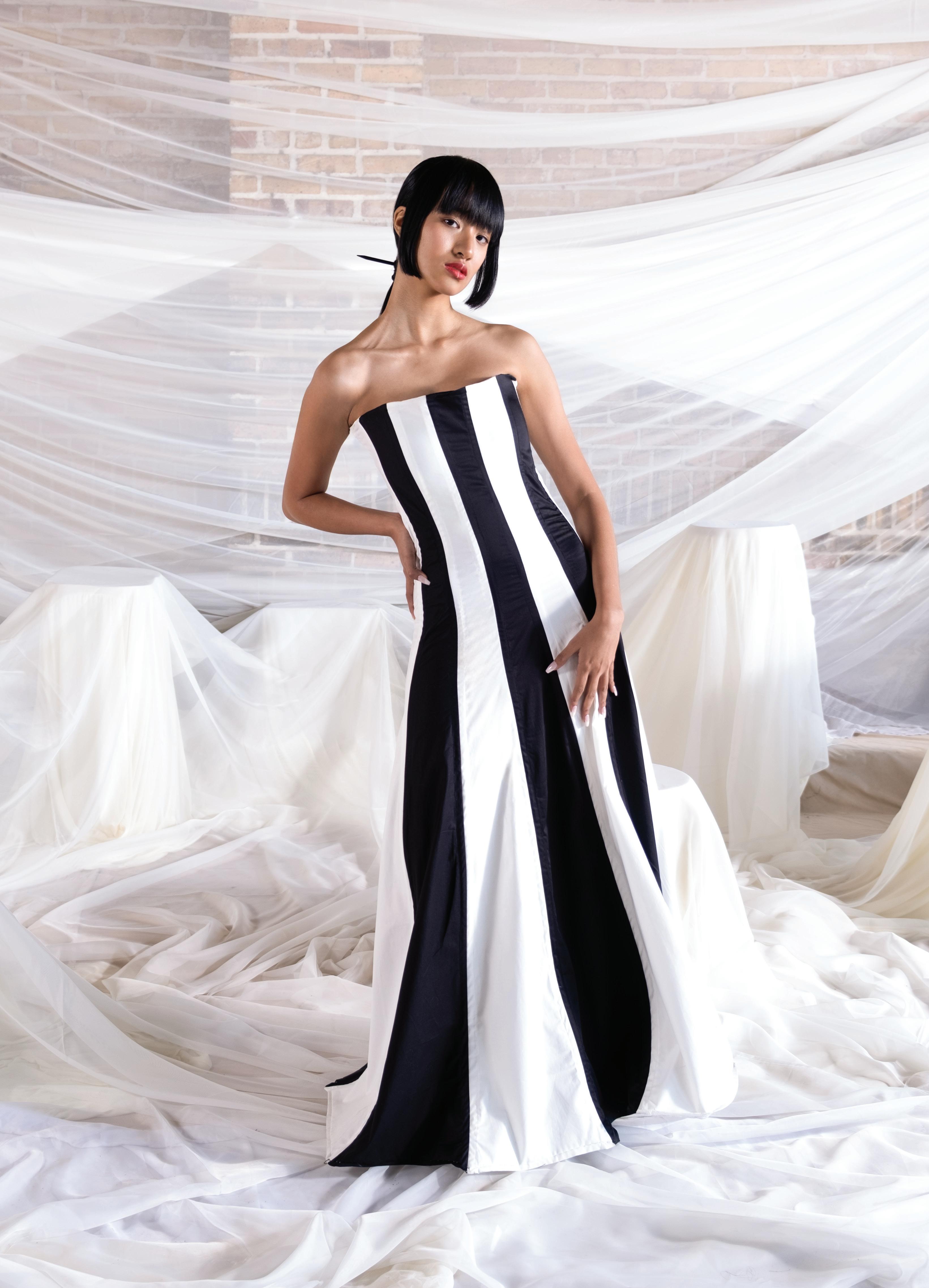
This is for Dr. Starke.
The nightmares started approximately 18 days ago. Today is May 9th.
May 9th
Her putrid smell woke me up around 2:30 a.m. My other senses are now involved. I am medicated; it will pass. Rot. Mold. The breath of something buried, trapped in wet wood. It clung to her, settled beneath her fingernails, seeped into the air between us. I couldn’t eat. My stomach turned. I did yoga before bed; I did what you told me. One breath. This is not real. One breath.
May 10th
She touched me last night. Her hands, damp with spores, slid across my face, their fuzz still lingering on my cheek. My nails were discolored this morning. One breath. This is not real. One breath. Every night she draws closer, sharpening into focus. Her features warped, collapsing in on themselves. Her skin cracked, oozing. The fluid from her mouth dripped into mine, and by morning, my lips felt slick. I wiped them raw. Eight days on the medication. It should be working.
May 11th
The pills must be making it worse. She lay beside me, heavy, pressing the side of my body. Her hands stretched over my ribs, pulling me into the wet heat of her body, her stomach thick and twisting beneath me. I felt the fog of her breath stacking, layering, slicking the back of my neck. My pajamas bloomed with colonies of mold. It won’t wash. One breath. This is not real. One breath. Movement should break the paralysis. I know that. I’ve read that. But why didn’t it? She shouldn’t be here every night; sleep paralysis breeds differentiation. But when I finally gasped awake, my mouth dry and my limbs trembling, the imprint of her weight remained. The sheets clung to a shape that wasn’t mine.
May 12th
I slept in another room. It didn’t matter. She found me. She woke me. She was angry. She vaulted onto my body –– no, no, no –– this was different. I was awake. I know I was awake. I kicked, I clawed, I gasped. She didn’t let go. Not at first. Three hours before sleep returned. My legs ache. A bruise on my shin. Beautiful spectral violet shaded by lime green. I must not have washed properly; I kick when I sleep sometimes. The colors look beautiful together.
May 13th
Chitinous fingers. Wet hands clenched around my throat. I couldn’t breathe. I woke up gasping, coughing spores from my lungs, thick
and cloying, like they had taken root inside me. My neck was raw, not red. Open, not bruised. A bloody wound dragging across my skin like a mark, a message. I am off the medication. Three weeks of her. Everything is blurring. I feel the dampness at my core, spreading. Miriam is feeding me something I cannot see. I have given her a name ––Miriam. Or maybe she gave it to me.
May 14th
She was on top of me again. Real or not real, I could fight. My fingers knew what to do before I did. Reach, reach, catch. Charger. A loop around her throat. A pull. Harder. Tighter. Her mouth gaped –– I wanted to see the pretty green and purple again. The mold coating my arms made it harder to grip her. Pieces of her screaming. I was right all along; I am not crazy, Dr. Starke. What a wonderful view I had. Pieces of her pain. Pain. I smiled. Real or not real, it was methodical. Intentional. My grip finally adjusted, using my slimy hands as an advantage now to massage her throat while she screamed; I could make her sing. Something burst beneath my fingers. Something soft, something rotting. Real or not real?
July 19th
Miriam left me everything I needed. Her room, hidden in the back of my closet, walls furred with growth. My missing clothes and lost Halloween candy bags tucked neatly in wet corners, waiting. The mold, scraped from her hands, smeared across the walls like scripture. I was right. The joy in correctness hardly compares to the memory of her gasping and writhing as I pulled the cord tighter. I won. Her swan song was hummed to the rhythm of Miriam’s wheezing. Real or not real, it didn’t matter in the end. But she left something behind: purpose. I understand now. Something is waiting to be grown.
Someone new has moved in.
I practice my entrance and exit while the people downstairs work. They replace floors and fixtures as if they can erase us. They are so vain. I have so much to proliferate. Miriam’s distasteful impatience with me halted her progress. She never let the fungus grow. This time, I will make it last. It just needs time to take root.
words FRANCESCA JAQUES

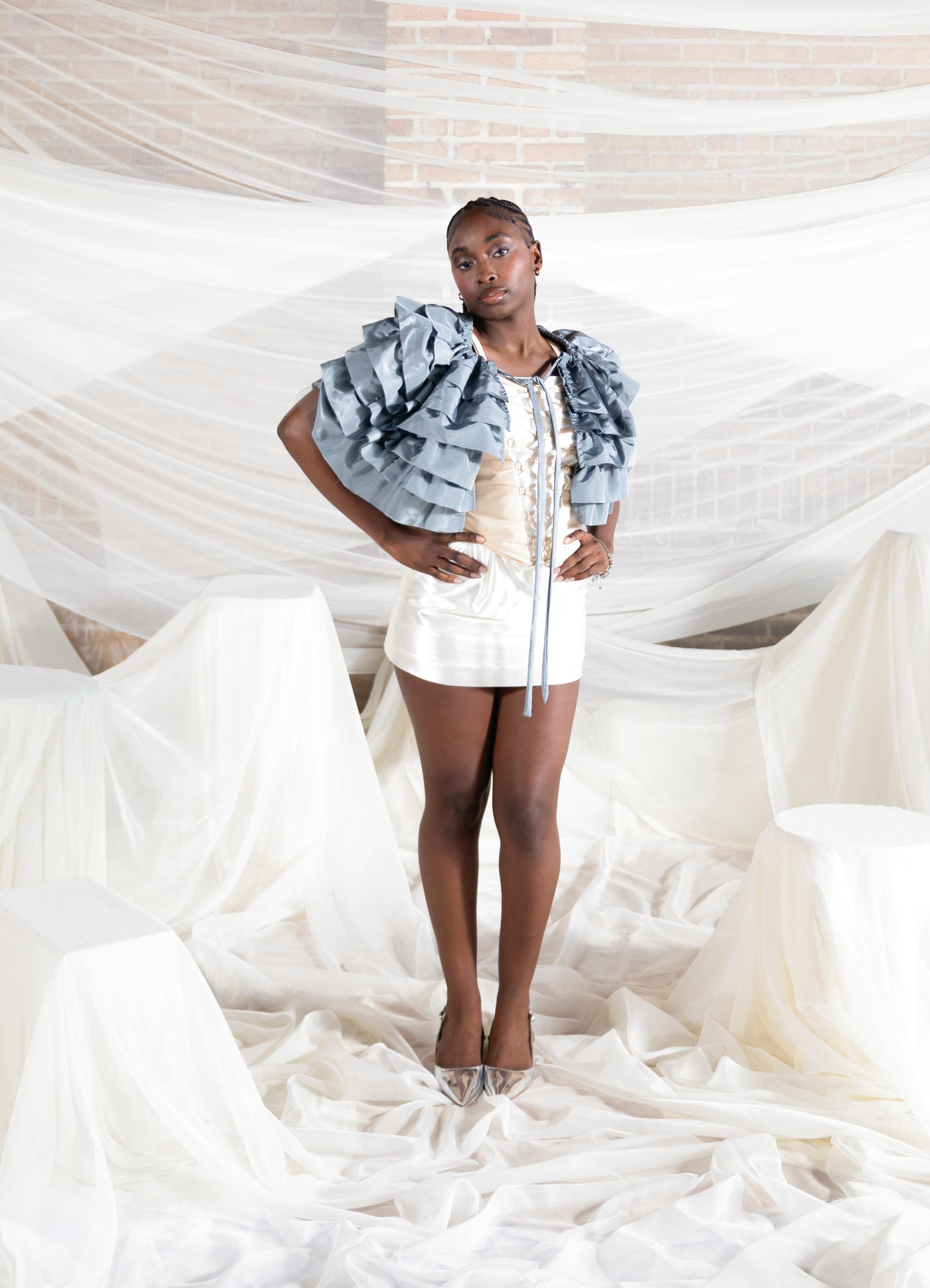

Featuring cover model Hanna Robinson, our Issue 14 Archive embodies ethereal elegance. This cover captures the boundless creativity and striking presence that define both our magazine and the vision behind this issue.



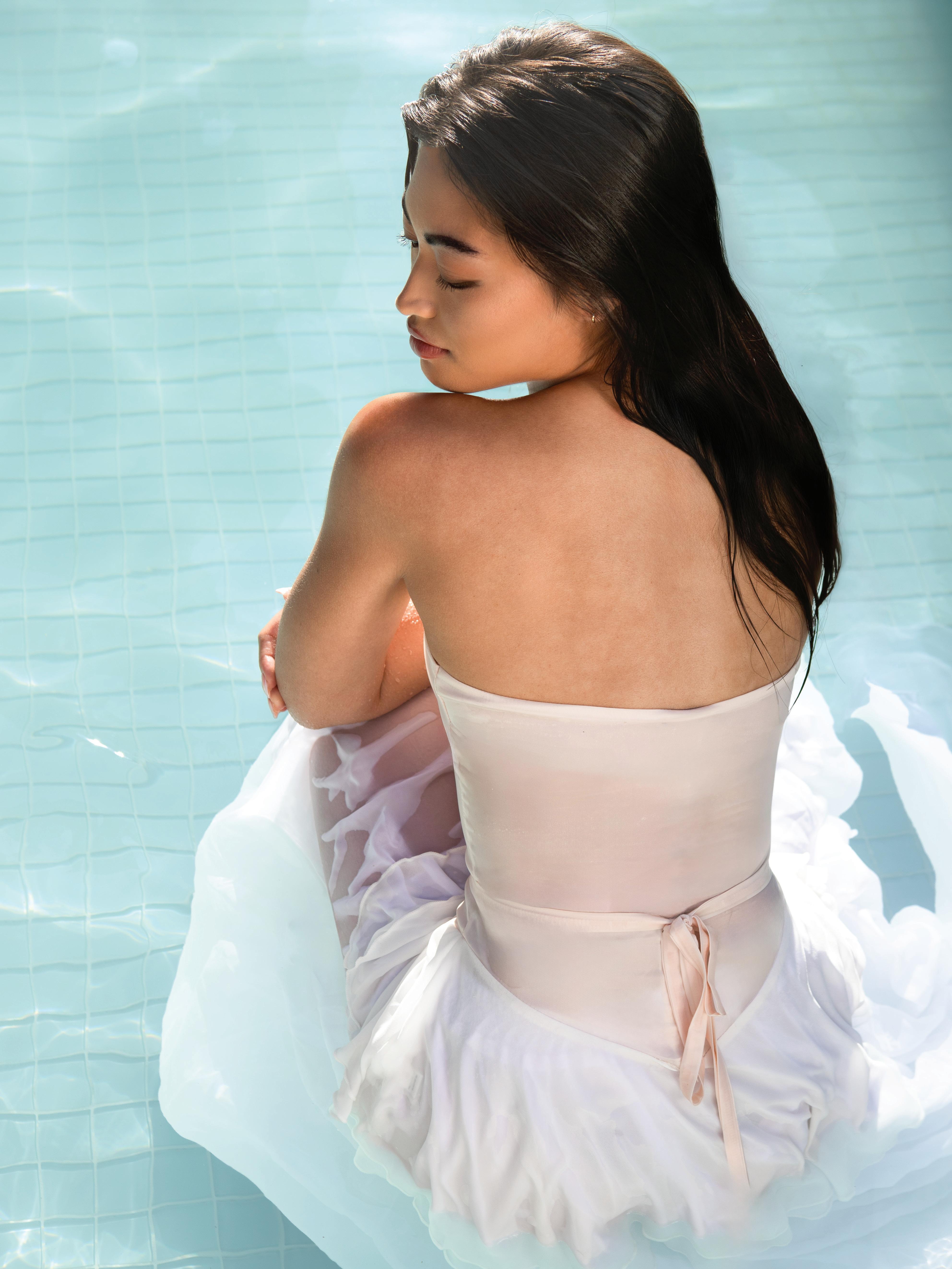

Manipal is a town that pretends not to listen. But it does. It hears the slap of chappals against scalding pavement and the resigned sighs of mothers in kitchens that are thick with burnt coconut and cumin. It hears boomsticks in temple courtyards, secrets in quiet houses. But like a good child, it stays silent.
Mango trees droop in the heat. Their shadows cover roads a young girl once walked on barefoot, with the tar forgiving beneath her feet. She was small then — small enough to believe the world ended at the last tea stall, where men sipped chai and spoke of dirty things in clean voices. She was small enough to overlook how a town full of frank foliage could be so unkind.
It was jackfruit season in Manipal when the girl first learned that silence could be heavy. Clouds swelled over the horizon, settling in for their afternoon nap. In the garden, the wild overgrowth trembled with the discord of moody frogs lounging on lilypads, deep in reverie. The walls of the house, stained with moss, bulged where the rain had pressed too hard and softened their bones.
Inside, the drawing room was cold: scented with camphor and damp upholstery, conversations freezing midair before forming. There, the girl sat cross-legged with her math textbook open while muttering equations under her breath. In the next room, a conversation. Low voices. Careful pauses. An unfamiliar, callous thud followed by a familiar, wincing silence. Her father rose to freshen his gin and tonic. Her mother struggled from the floor, collecting her wedding bangles.
The tea sat untouched that day, cooling in the modest air. She never saw what happened after, only her bruised mother laying banana leaves for dinner and her father retreating to his study. Her fingernails scratched her throat, painting the porcelain bowl with specks of vomit. And the next morning, the garden seemed wilder than before. The jackfruit tree bent as the cooks harvested its fruit for the morning’s appam Years later, in London, she would sit at a polished wooden table, turning a baby potato over in her palm.
In the West, nobody had heard of appams. At a boarding school across the sea, she sat staring at it. Small, golden and whole. The taste of damp earth curling in the back of her throat, the memory of a house that had swallowed secrets much easier than she could swallow the potato sitting in its jacket, steaming as she brought it to her mouth.
While she was away, the house held its breath. Over time, it had learned to keep secrets the way women kept two-carat diamond rings hidden in cupboards — for safekeeping. Outside, the monsoon raged. Inside, nothing moved. Not the heavy drapes against the sun. Not the mother at the table, fingers tracing the rim of a steel dhaba and her replicated ring placed neatly beside it.
“Cali, cali, cali — what nice boy will marry you now?”
Voices of rotten-toothed, well-meaning aunties pervaded her mother’s head. The weight of expectation seeped into the house, staining it in patches. So when the tailor wrapped the tape around her 23-inch waist and paused at the back, declaring the engagement salwar measurements, she did not ask why.
Girls grew up knowing — knowing how to listen without hearing and watch without seeing. How to swallow words before they leave the tongue. A lesson passed down in the way sari pleats were tucked; how hot tea was poured but never finished.
In May, the invitations were sent, pressed between sheets of vellum. The town, unblinking, watched another girl step into her mold. The lean-legged and buttoned-up man before her, with a kind smile and a tomato soup-dotted mustache, was to be her sweet responsibility for life.
The processional lasted five days.
Outside, the monsoon mourned. A mango fell, overripe, splitting open on the ground.
The cold in Detroit was not like the drawing room. As the blanket of snow fell gently, she screamed in the backseat, her newborn daughter red and plump, as she thought, “God, what have I done?” The sweet man’s hands tightened around the wheel. The weight of it — all of it — sat heavy in her chest.
She had left. And yet, silence followed.
It was the kind she had unknowingly inherited, turning love into duty. The house she tended to, pride, joy and all, whittled down to a museum of string lights in winter and colored eggs in spring.
Her daughter, paralyzed by the fear of becoming like her and possessing the privilege of never having to become her, spent years mocking her. She drank liquor instead of tea. She folded her life into others, leaving no space for herself.
Slamming the wooden door, she promised herself, “I will never be like her.”
And yet here she was, sitting at the vast kitchen island, 18, staring at her closed-mouthed college town, wondering if her mother had ever felt the same quiet fear. This knowledge of burden, of secrets that rot you from the inside out, of hiding for safekeeping until it meant losing yourself entirely.
The car slowed as they pulled into the driveway. Behind her, the baby had ceased crying, her tiny chest rising and falling in the moonlight. She turned, taking in the impossibility of her and the realness of a life she had created.
In a drier town across the sea, a mother and daughter sit facing each other, the silence between them no longer heavy. The daughter finally sees her mother for what she is — not a cautionary tale, but a biscuit never crumbling in a hot cup of tea. And, for the first time, she sees herself.
She wraps her hands around the steaming cup before her.
The snow stops falling, and the radio whirs in the background. Behind her, the baby stirs, small and whole.
In Manipal, the monsoon continues. A mango falls, decomposing into the soil. But this time, something else takes root. Something supple and sage, watered and nurtured by the speaking of silent truths.
Though no words can fully capture my immense gratitude, appreciation and love for this publication and the Strike Magazine community, this letter is my attempt.
I joined Strike’s staff as a Brand Ambassador during my freshman year. I will never forget the electric feeling that consumed me during that first semester on staff. It was apparent from the beginning that Strike was an extremely special place and that the talent, creativity and excellence it held were unlike any other community. While I then, and even more so now, will always have an appreciation for the art we create, what I value most is Strike’s staff as the most integral and unique part of Strike.
Throughout my time at Strike, I have been fiercely dedicated to helping others find their place within Strike while discovering their true self. I joined Strike unaware of my potential and capabilities, simply trying to learn as much as possible from those around me. I never would’ve guessed the extent of Strike’s impact on me. Reflecting on the last four years, it is evident that being on and serving Strike’s staff has been the most impactful experience of my lifetime. I credit my experiences on Strike for the growth I have experienced as a professional, leader, creative, student and individual.
I am filled with the utmost gratitude and respect for the staff members who have become my family. To my predecessor, Jacob Wall, thank you for seeing what I could never see in myself. I am eternally grateful for your leadership, support and friendship throughout this journey. Continuing the greatness you and previous editors built before me is an honor.
To Isa De Miguel, thank you for being my ultimate role model, instilling skill and confidence in me through our time together Issue 12. It was your guidance and mentorship that prepared me to step into this role as Editor-in-Chief.
To my Assistant Editor-in-Chief Olivia Hansen, assistant I am forever in awe of your talent and leadership abilities. Thank you for your unwavering dedication to our Strike staff. To my family and friends, thank you for your constant support, encouragement and love. All I am is because of you; this journey would not have been possible without you.
To my perfect, beautiful staff, whom I now see as my family, I hope my love and appreciation for each of you were apparent during my time on Strike. Thank you for trusting my leadership and supporting me as Editor-in-Chief. I will forever cherish the time we spent together and the opportunity to witness the immense talent and creativity you all possess.
To my fellow Strike Seniors, though our Strike journey is coming to a close, I am confident that each of you will carry the professional skills, confidence and experience that this organization gave us into your next adventure. Continue to create fearlessly, inspire relentlessly and lead with intention. There is no limit to what you can achieve.
Finally, to my sisters, our External Affairs Director Heather Parrish and Creative Director Rachel Frenchman. You both showed me a level of friendship, support and loyalty I never knew existed. Rachel, thank you for inspiring me daily to become a better version of myself. You led Strike not only with your inspiring creative vision but also with kindness, empathy and integrity. Heather, thank you for completing me. Your drive, passion and exemplary leadership skills have pushed Strike to new heights this past year. I will forever be in awe of the woman, leader and friend you are. None of this would have been possible without both of you, and I am eternally grateful for that. Thank you for being the most remarkable individuals I know.
Strike Magazine has transformed me, and my greatest wish is for others to be as profoundly inspired, motivated and changed by this publication. It has been the highest honor to carry forward the legacy of such immense talent that came before me, and I am confident that this staff and community will excel for many issues to come. The magic of Strike is in the people who pour their hearts into it, and I will forever cherish being part of this legacy. All my love, forever and always.
Out,


I am at a loss for words to express my gratitude to this organization and its people. Strike Magazine Gainesville, you have not only changed my life but also fostered my personal growth in ways I could never have imagined, and I am a better person because of it.
Four years ago, I was unsure of where my time in college would take me. Strike became more than just a place of comfort, creativity and collaboration. It became a community where I felt I could fully be myself and was encouraged to be. I joined as a Bookings Assistant for Issue 07, which consisted of running around Gainesville collecting loafers and purple tights for photoshoots — a job I would do 100 times over if it meant I got to be a part of Strike.
However, my time with this publication has not been linear, and it wouldn’t be my Strike journey if I didn’t mention every aspect of it. Before Issue 10, I made the extremely difficult decision to step back from Strike. Not being immersed in the community I called home was challenging, but it only solidified how much Strike meant to me and how desperate I was to return to it. Since Issue 11, I have never looked back. As cliche as it sounds, you don’t know what you’ve got until it’s gone.
I owe so much of my experience with Strike to Marisa Greenberg. You helped me find my way back to Strike, and working with you has been an incredible privilege. Your confidence, support and friendship are unmatched. Thank you for being the best friend and “work wife” I could ask for.
I would also like to extend my gratitude to the editor board. To Sophia Johns, Rachel Frenchman, Caroline Rives, Jesse Pickel and Olivia Hansen, I cannot thank you enough for giving me the courage to lead and always supporting me. I am beyond grateful to have worked alongside you all and am so proud of everything we have created together.
To our Editor-in-Chief, Sophia Johns, you are the heartbeat of this organization. I have never met someone more driven, caring and dedicated to their craft than you. Your love for Strike and its people is admirable, and we are so lucky to have you lead us. You have made me a better leader, friend and person. There is no one else I would want by my side through college and life. You are one of a kind, and I am so proud of you.
To our Creative Director, Rachel Frenchman, you are the brightest light in every universe. Your talent, attention to detail and creativity go beyond the imaginable. Thank you for being my biggest source of support and inspiration and for pushing me and this publication past our limits. It is the greatest honor to have witnessed your creative direction. The relationship you, Sophia and I have created is one that I will cherish for the rest of my life.
To my external teams, I am so proud to lead you. Every moment spent collaborating and connecting has been a joy. Thank you for trusting me and embracing me as I am. Seeing each of you grow as individuals has been truly inspiring — you are more talented than you’ll ever know.
To everyone who has come before me, thank you for setting the bold, striking standard of Strike Magazine Gainesville. I am grateful to Erin Hu, Kate McNamara, Lauren Casole, Jacob Wall and Isa De Miguel for being excellent sources of inspiration and guidance. You have all left an invaluable mark on this publication and me.
To our Issue 14 staff, editorial, creative and external, you are my why: why I chose to step into this position and why I choose every day to work my hardest to make you all proud. Our connections and memories have been some of my most cherished in college. Thank you for being exactly the people I needed in my life — I look up to you for your spirit, creativity and kindness.
As my time with Strike comes to a close, the words “bittersweet symphony” come to mind — the simultaneous beauty and hardship of experiencing something so profound, yet having to leave it behind me. Strike, you are my home, my legacy, and I will forever be in debt to you. Though my chapter with Strike is ending, I am eager to witness the incredible future that awaits this publication. I have no doubt that the next generation of Strike staff will continue to push boundaries, inspire change and create a lasting impact. From the bottom of my heart, thank you, Strike Magazine Gainesville, and for the final time, strike out.
Loyally,
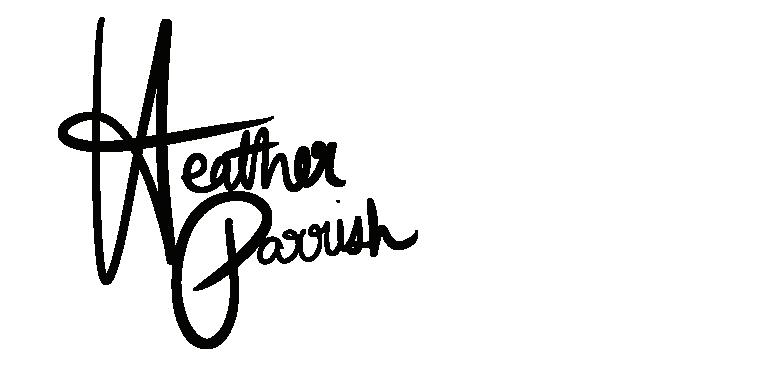
Heather Parrish


Thank you to our models and contributors.
First Magnitude Brewing Company
Reagan Alapa
Marcia Branker
Michelle Chi
Brooke Cohen-Pinsky
Daniel De Aguiar
Sean Durr
Gabriel Fernandez
Valentina Galvan
Ethan Garrepy
Holly Goldstein
Dorian Holt
Jacob Hoppenstedt
Lilly Johnson
Maya Karp
Don Kennedy
Sara Kramer
Nathan Kim
Hyunwoo Kim
Mckenna Lorenz
Brenner Mauldin
Deon Mathew
Dori Miller
Marceline Myo Thi
Isabella Pascuzzi
Riana Prasad
Stussy Riegel
Hanna Robinson
Isabella Rodriguez
Jemima St Pierre
Allan Stewart
Mikayla Summerall
Alvin Wu
Ella Xu
Katharina Wood Koepcke
Riley Young PARTNERS
Contributors


